👋 Have a question? I'm Ecee, an AI Chatbot here to help you find what you need.
👋 Have a question? I'm Ecee, an AI Chatbot here to help you find what you need.
Ultimate Guide
As IMPACT's Director of Content, John writes, edits, and coaches internal contributors. He also interviews subject matter experts and oversees all content strategy and production.
At its core, inbound marketing is simple. Rather than interrupt your audience with traditional outbound marketing methods (billboards, print ads, radio spots), you attract them to you with high-value content.
After all, we know how we behave as buyers. Chances are, before a big purchase, you do a ton of research. When you find resources that are trustworthy, you form a positive opinion of that brand. You might even buy from them.
The idea is a sound one.
However, the problem is that most of the inbound marketing experts and educational resources out there only cover basic, surface-level inbound marketing strategy — and they don’t offer much insight past that. While these tips and tactics might help you get started, they won’t sustain the long-term growth that is truly possible with inbound.
Here at IMPACT, we've taught hundreds of businesses how to improve the way they go to market using our They Ask, You Answer framework. It’s the one piece to the inbound marketing puzzle that makes inbound work for any business, in any industry.
Here are just a few of our clients that have transformed their businesses through their inbound marketing efforts:
Mazzella Companies: Increased their revenue by $20 million and web traffic by 256%.
RoofCrafters increased their inbound leads by 400% and increased overall annual revenue by more than $1 million.
ThoroughCare doubled its revenue four years in a row.
We’ve created this guide because we want your business to experience the same incredible results. For this reason, we’re not only sharing with you everything you need to know about the basics of inbound marketing, but we’ll also teach you how to apply the They Ask, You Answer framework to your strategy to create a truly successful inbound marketing campaign.
In this guide, you’ll find:
These resources will help your business make an inbound marketing strategy that actually drives results.
Let's get started!
Inbound marketing is a digital marketing strategy in which a business organically earns the attention of its ideal buyers at different stages of their purchasing journey (awareness, consideration, and decision) rather than having to seek them out and compete for attention through outbound marketing.
Consider these eye-opening statistics:
The bottom line is, your prospects go to great lengths to ignore your attempts to market to them. So, rather than putting your audience on blast and demanding they pay attention to your message, with an inbound marketing strategy, you create high-quality content and experiences that your customers actually seek out. In other words, inbound marketing focuses on what the audience wants, and that's why inbound marketing works.
The inbound marketing funnel visually represents the stages someone goes through leading up to a purchase:
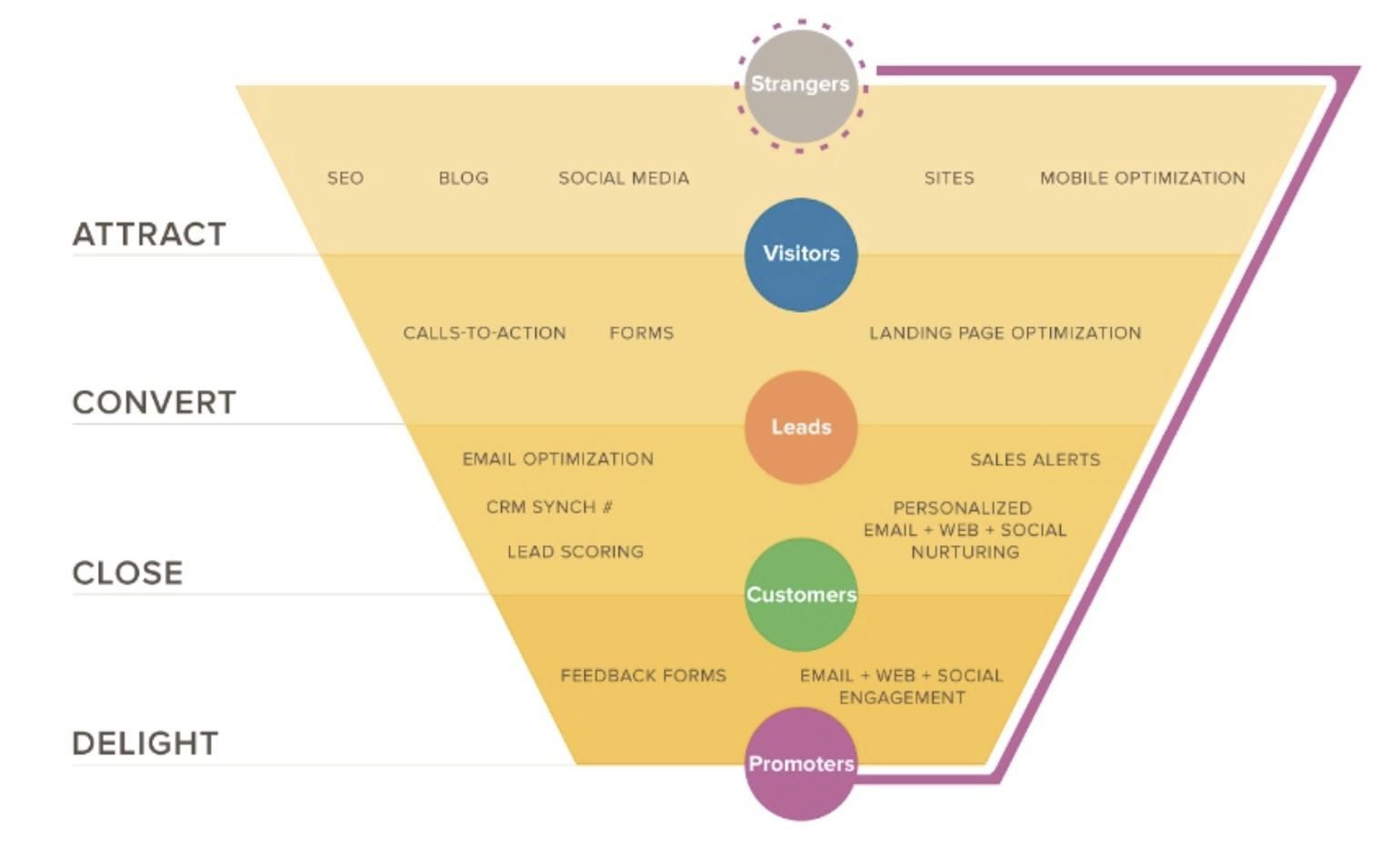
[Source: Responsify]
In each of the four stages, there are specific methods used to guide people toward a purchase.
The first stage in the inbound marketing funnel is attracting visitors to your website. But you don’t want to attract all visitors, you want to attract the right visitors.
Components of the “attract” stage of various marketing strategies include:
Once visitors have found your website, your videos, or your social channels, you want to build a relationship with them and turn them into followers, contacts, or leads.
Components of the “convert” stage of inbound marketing include:
The “close” stage of the inbound marketing funnel is where you guide leads through the sales pipeline toward the final buying decision.
Components of the “close” stage of successful inbound marketing campaigns include:
Even after you’ve made the sale, you can continue to engage and delight your customer base to turn happy customers into promoters of your business.
The “delight” stage of an inbound marketing strategy may include:
The inbound marketing methodology was designed to meet prospects’ specific wants, desires, and needs by sharing relevant content and resources.
The methodology aims to form connections with prospects by helping them solve their problems and matching them up with a solution and was created by HubSpot co-founders Dharmesh Shah and Brian Halligan. It utilizes many different forms to create brand awareness and attract new business.
These forms include:
This content is created to answer common questions, pain points, and challenges your customers face, to evolve the buying experience into a more seamless and touchless process.
Let’s dive into the specifics of the inbound marketing methodology to learn how you can use content to be the No. 1 teacher in your space in the digital age.
Inbound marketing is effective and unique in that it doesn’t force its message on your audience, while traditional outbound marketing is marketing geared towards reaching as many people as possible (think billboards, print ads, cold-calling, etc.), inbound marketing is focused on getting found by the right people.
No one wants to be “sold to” anymore. Rather, they want to come to their purchase decision on their own.
Inbound marketing has come a long way since Halligan and Dharmesh first introduced the concept in 2007. While the inbound marketing funnel concept and phases are still used to understand how our prospects move through the buyer's journey, the original funnel has been reimagined to better reflect the overall customer experience, which HubSpot says is cyclical: it never ends.
For this reason, HubSpot has since changed its funnel into a flywheel. The original four stages of the funnel are represented by just three similar phases: attract (strangers), engage (prospects), and delight (customers).
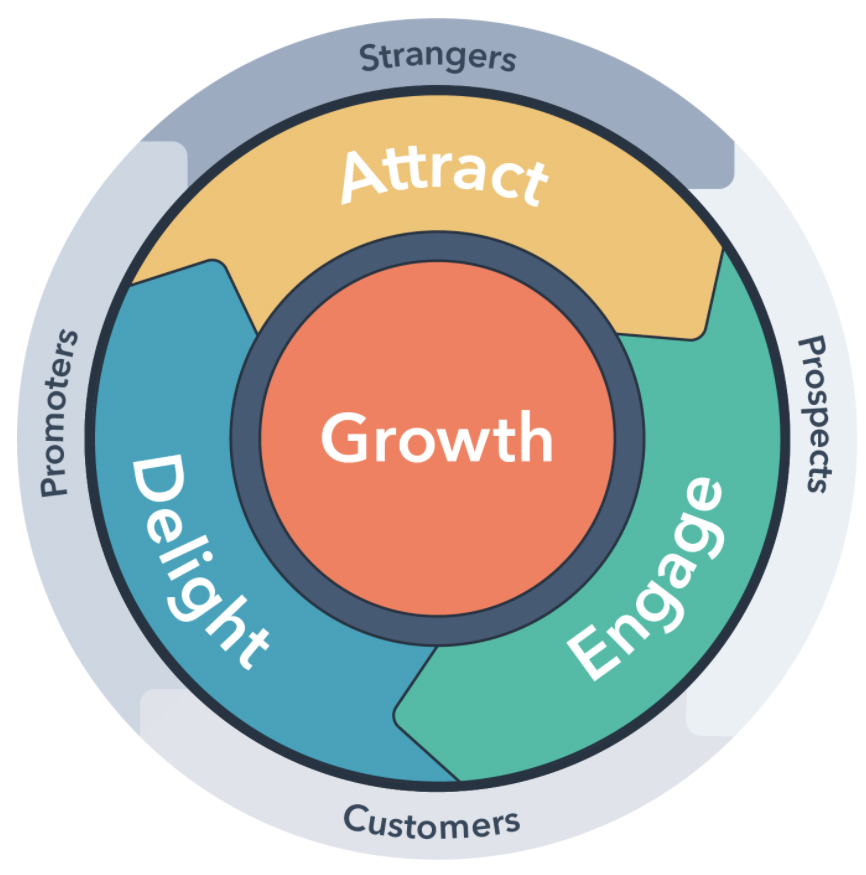
Here’s a quick video from HubSpot that explains why they made this change:
While the two models look slightly different, they function in similar ways. The bottom line is you need to figure out how to cater to prospective customers at each of these steps — turning your visitors into leads, and your leads into customers, and your customers into lifelong fans.
You don't truly see the long-lasting, transformational results with your business through inbound if you don’t commit to doing it the right way.
It can be difficult to get the ball rolling, but once your team hits its stride, you can build momentum and see steady, reliable results.
One of the things we teach our clients how to do is align sales and marketing for better inbound marketing results. We do this with what we call revenue teams, where members of sales and marketing teams regularly meet to brainstorm content ideas, track shared metrics, and align on messaging.
When sales and marketing teams are fully aligned:
Here at IMPACT, we teach our clients to create their content in-house so the voice and information resonate more with their prospects. We also teach them to involve sales to be sure they're creating the content that truly moves the needle.
Whether you reach prospects with blog articles, videos, social posts, or emails, the benefits are as follows:
Many businesses think of inbound solely as a marketing initiative, but, when done right, its biggest impact is on sales.
Here’s how inbound marketing can benefit your sales team:
In short, the real benefits of inbound marketing aren’t just wins for marketing. Inbound marketing — when properly implemented — is a sales-focused, full-company initiative where everyone wins, and you can see the results in your bottom line.
According to Google, roughly 80% of buyers research online prior to making a purchasing decision — long before they even think about contacting someone in sales or reaching out to a company for more information on their products and services.
Inbound taps into this buyer behavior and is designed to better align your organization with the buyer’s journey, the natural process a modern buyer goes through when searching for a solution online.
How the buyer’s journey works:
In short, inbound marketing is designed to help prospects understand their problem and discover the solutions you offer.
As opposed to using inbound marketing to help people find you, outbound marketing aims to reach as many people as possible, whether or not they are active buyers.
In the past, old-school marketers put their products and services in front of people with outbound tactics such as:
In the modern digital era, that list has expanded to include Facebook Ads, Google Ads, and other paid media strategies across platforms such as LinkedIn.
In direct contrast to inbound, these tactics (traditionally) have been put out into the world as interruptions. The piece of mail you didn’t ask for, the commercial you skip through (thanks to on-demand technology), the Google Ad that’s in the way of the organic results you’re looking for.
Anyone who says that either inbound or outbound is always superior is giving you a biased answer. To determine which one is best, you have to consider your specific business, audience, and your marketing objectives.
Inbound and outbound marketing are two separate approaches that can be used effectively on their own (or even together). Each one has its unique set of advantages and disadvantages. Outbound is a better short-term solution with higher long-term costs, while inbound marketing tends to be the better long-term solution with its own set of associated investment costs.
In this chapter, we’re diving into a range of inbound marketing examples that have been created by companies that are successfully using inbound marketing to drive sales, so you can use them as inspiration for your own strategy. We’re talking high-performing, revenue-generating content, web design, and tools that have helped these clients of ours grow exponentially by attracting traffic, capturing leads, and driving sales.
When it comes to content, there are topics you should cover about that drive far better traffic, leads, and sales. Yet most businesses aren’t willing to address them.
These topics are so effective because they directly align with the questions customers are asking, both in search engines and in sales conversations. But, they can sometimes be uncomfortable for businesses to answer, and businesses ignore them at their own peril.
We call them The Big 5, and they include:
Here is an example of how an effective pricing article is written. (For more information, here are examples of all of The Big 5 topics for inspiration when creating your own).
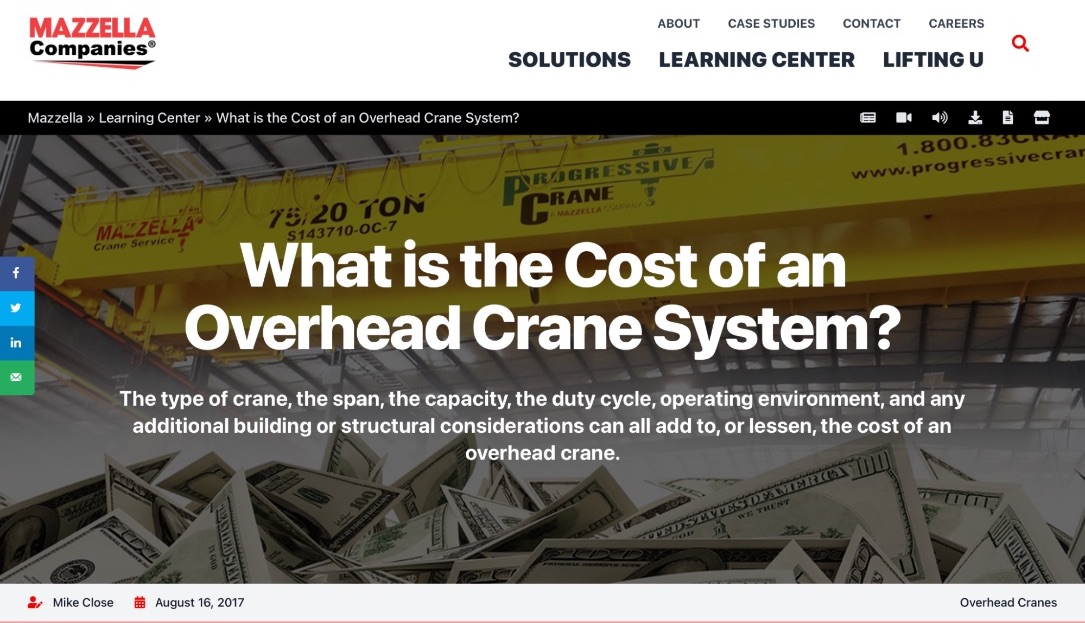
This article by IMPACT client Mazzella Companies is the perfect example of how to approach an often touchy subject for businesses: cost.
Although cost and pricing is something most businesses shy away from talking about openly, we know our buyers want to know it.
Why this example works:
Video content is vital to every modern business, no matter your industry. Here at IMPACT, we teach our clients how to create seven highly effective types of videos so they don't waste money producing content that doesn't move the needle.
We call them The Selling 7:
The example below represents how to create an effective 80% video. (Here are some more The Selling 7 examples so you know how to create each.)
If you ask your sales team how often they get asked the same questions over and over again, they’ll likely tell you "around 80% of the time." Instead of your sales team answering these same questions during each sales call, you can create an 80% videos that answer these questions in advance.
An example of one of these videos comes to us from IMPACT client Sheffield Metals, in which they go over nine things you need to know before buying a metal roof.
Why this example works:
Imagine how useful it would be to send a video like this prior to a sales call.
When buyers find your website, they immediately want to know whether you can solve their problem. To create an effective inbound marketing website, you need to focus on what your prospect needs, not how great your company is.
These website designs show how a useful website could look.
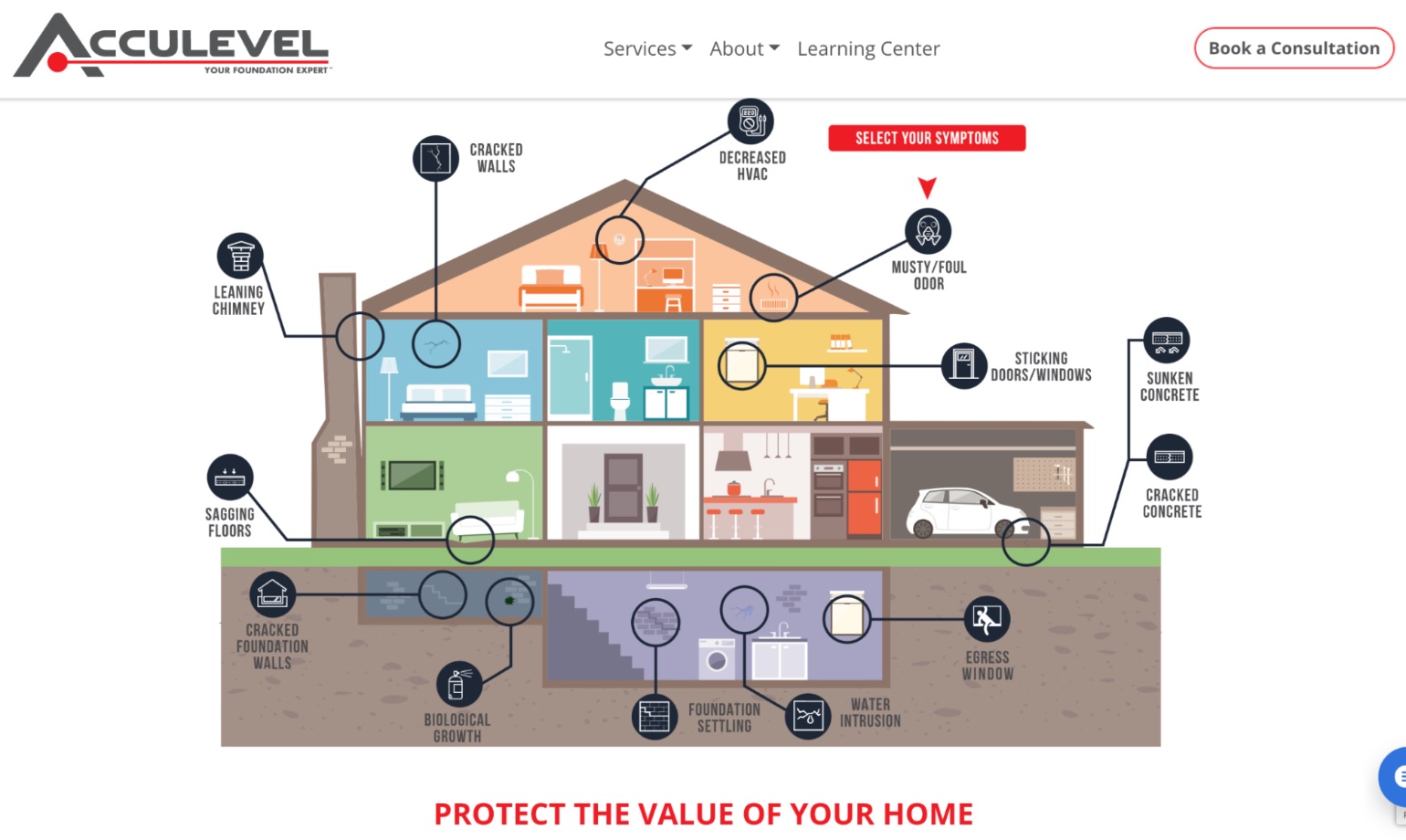
Why this example of a website works:
This inbound marketing website clearly and easily leads prospects through the buyer’s journey, while educating and empowering them to make their decision along the way.
Nearly all of the content on your website, other than your products and services pages, should be educational information that answers all your prospects’ questions and nudges them toward a sale.
This learning center example comes to us from River Pools, which does this exceptionally well.
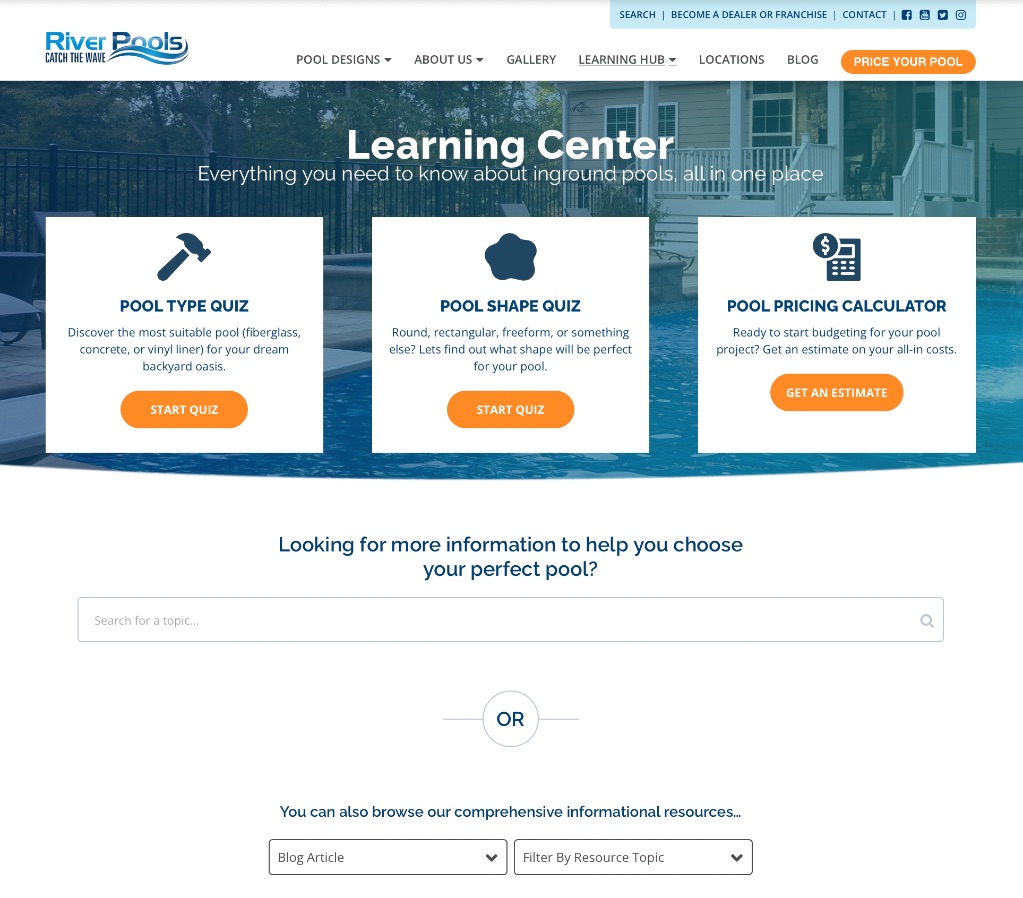
Why this example works:
All these elements serve to help the prospect find what they’re looking for.
Newsletters and email campaigns are a traditional part of the inbound marketing methodology that are still relevant. Newer approaches, such as AI-powered chatbots and self-service tools, are on the rise.
Here is a sample of what some of our most successful clients are doing in these categories.
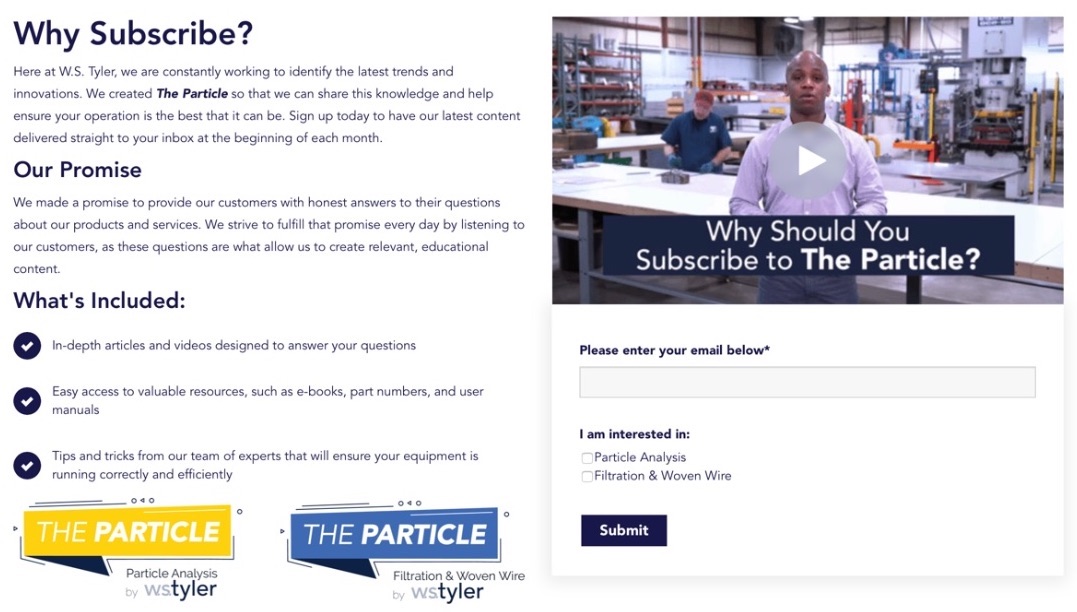
A manufacturer of women’s wire cloth and mesh materials, W.S. Tyler launched a wildly successful “choose your own adventure” style email campaign. Based on their answers to multiple-choice questions, prospects are sent inbound marketing content that is directly related to their choice.
Why this example works:
These emails were so effective for W.S. Tyler that they achieved a 74.14% open rate, which is basically unheard of, especially for unengaged contacts.
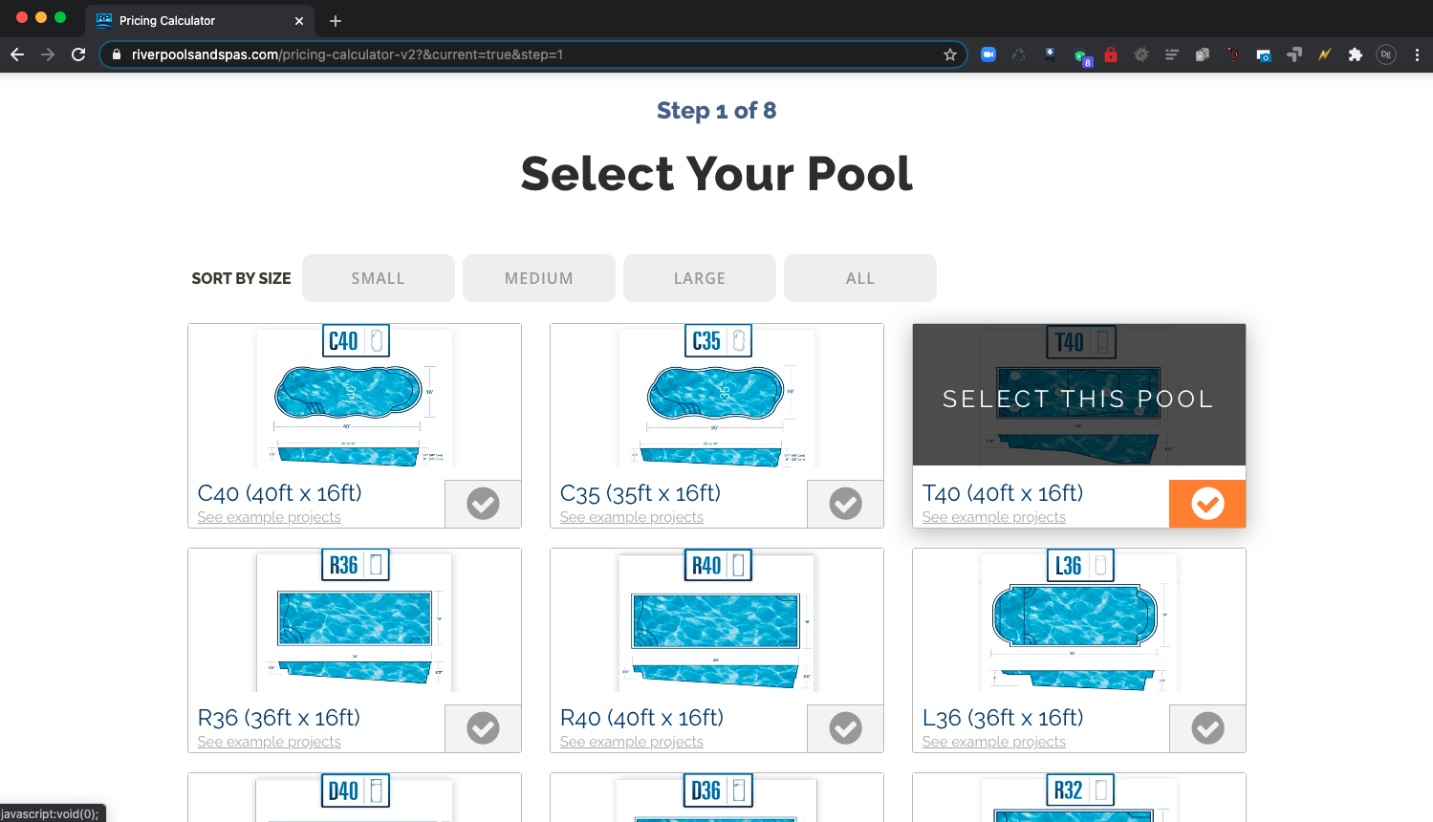
River Pools has an awesome pricing tool to help you find the perfect swimming pool for your backyard.
Why this example works:
At the end of the process, after the prospect enters contact info, the quote gets sent off to their mailbox. It’s a quick and easy way to empower buyers to make their own choices.
An effective inbound marketing framework unites your marketing and sales efforts around a single question: What do my buyers want to know?
If you approach your entire inbound marketing strategy with this question in mind, you’ll always be on the right path.
Here are the steps to build an inbound marketing strategy.
You can’t evaluate your own success if you don’t know what that success looks like. For this reason, the first step is establishing goals. Just like with any marketing initiative, you need to think about what you’re trying to accomplish with your inbound marketing efforts.
How do potential customers find you? It starts by knowing what they’re searching for. Keyword research can show you what the hot search terms are in your industry, as well as how competitive the search landscape is. You can learn about what your competition ranks for in order to best channel your inbound marketing efforts. Also, you'll need to know where they spend their time. It's difficult to focus on a spectrum of social channels all at once. Instead, focus your efforts on one or two platforms most likely to be effective.
Someone actually has to be doing the writing and video production. You basically have three options, all with pros and cons.
At IMPACT, we recommend you hire an internal team because it’s more efficient, cheaper, and produces higher quality, but this option has its drawbacks as well, such as making sure to hire the right people and provide the proper training. With modern AI tools, a savvy marketer can create a variety of high quality content — all while making sure your brand doesn't lose its humanity.
Content writing involves a lot more than just writing. It’s keyword research, brainstorming meetings, building reports, evaluating and updating older content, and more.
For your inbound marketing to be successful, you’ll need to plan how all of this gets done. This means building processes and creating a clear meeting cadence.
There’s no way around it: inbound marketing can be a lot of work. Building a library of valuable content for your audience takes time. At IMPACT, we advise our clients to publish two or three new articles each week. If you’re able to keep this pace up for a year, you’ll have over 100 articles.
We recommend using HubSpot to track and evaluate your inbound marketing. With packages ranging from free to enterprise-level, there are options for every budget. HubSpot offers custom reporting options that provide granular insight into content performance — everything from traffic analysis to revenue attribution.
If you’ve got the basics down and a good head of steam, it’s not time to rest on your laurels. What are other ways you can use inbound marketing to help your organization?
As with anything related to inbound marketing, think creatively about the needs of your customers and the strengths of your team.
The following content marketing formats are some of the most useful (read: effective) at attracting leads and boosting sales, and the examples in this guide will show you how other businesses are executing them so you can see concrete digital marketing ideas that actually get results.
These content formats will help your business gather and convert more leads and build better relationships with your buyers, no matter where they are in the buyer’s journey.
Blog articles are some of the most-used content marketing formats — and for good reason. Businesses that blog typically get 67% more leads per month and generate 13 times the ROI. When developed properly, blog articles help digitally-driven consumers find your website and learn about your products and services.
The key is avoiding fluffy content that might inflate vanity metrics but not drive business. Although you can certainly use AI to speed up the process, don't blindly publish AI-generated content. you're likely to end up with derivative articles that may be plagiarized from other sources.
To start, stick to the Big 5 (which we outlined in Chapter 4).
Learn more about these high-converting articles in our free course How to write “The Big 5” best business blog topics.
If there was a “Drop whatever you’re doing, and try this!” piece of advice in content marketing, it would be to incorporate video into your digital marketing strategy.
People watch an average of 18 hours of video online, and when it comes to learning about products and services, 69% revealed that video was their go-to source. This is because video is a quick and easy way to digest a wealth of information, and for your prospects who aren’t big readers, video can be a powerful way to connect with potential customers who might otherwise skip reading your blog.
Plus, video can live everywhere — your website, YouTube, social media, emails — so it's important to think creatively about what you produce.
Cover The Selling 7, and you will be amazed at how much easier your selling process becomes.
With an average 3,600% ROI, ($36 for every $1 spent), email remains one of the most effective way to keep your customer engaged with your business. But with over 293 billion business and consumer emails sent and received per day, it’s also good practice to keep your outreach succinct and helpful rather than salesy and pushy.
When in doubt, think less about your company and more about what you can send to your customers that teaches them something and builds a better relationship with them, even if it seems simple.
Guidebooks provide an in-depth look at a certain subject. Because they're meaty and detailed, they tend to rank well in search — but it's best if you bring a unique point of view, original research, or something else to stand out from the crowd.
There were roughly 118 million monthly podcast listeners in 2023. For some, podcasts are an ideal way for users to consume books or learn something new while they perform some other task, like doing the dishes, walking the dog, or commuting.
You can create a podcast from existing pieces of content or chat about different topics with subject matter experts or guests. A great way to use podcasts for building traffic to your site is by posting the audio file along with a transcript, so the keywords are on the page as well.
Tools such as Riverside or Descript can make recording, editing, and cutting clips a breeze. You'll get AI-generated transcripts, ready-to-post social clips, and more.
Whenever I think of whitepapers, I think super nerdy, in-depth scientific texts with lots of charts and figures that doctors and engineers enjoy. They’re the textbook-like content subject matter experts love. Just one warning: If you’re going to label something a “whitepaper,” it needs to be as in-depth and informative as your readers will expect.
Checklists are a fun and easy way to help your prospects learn about a topic and all the steps needed to make it happen. It helps those unfamiliar with what you do take action toward accomplishing their own goals.
Find out which platforms your particular audience frequents based on their demographic information and create engaging social media posts that show how you can help them.
If you have a restaurant, post pics, behind-the-scenes videos, giveaways, and recipe secrets. If you build overhead cranes, create infographics that show the cost of such a purchase. If you own a quaint bed-and-breakfast, share a picture of how your guests are finding comfort and enjoying a restful stay at your inn.
Case studies, which are a form of client testimonial, can be some of the most powerful content on your site. Being able to show that a company or client achieved amazing results by working with you helps prospects see how they can be helped too. It builds the trust some need to take that leap of faith in choosing your company over all others.
These first ones are content marketing tools and apps for when you're putting together content strategies, performing keyword research, and so forth.
Let's start strong with Semrush's end-to-end Content Marketing Platform that helps you to build a data-informed content strategy focused on your audience's needs.
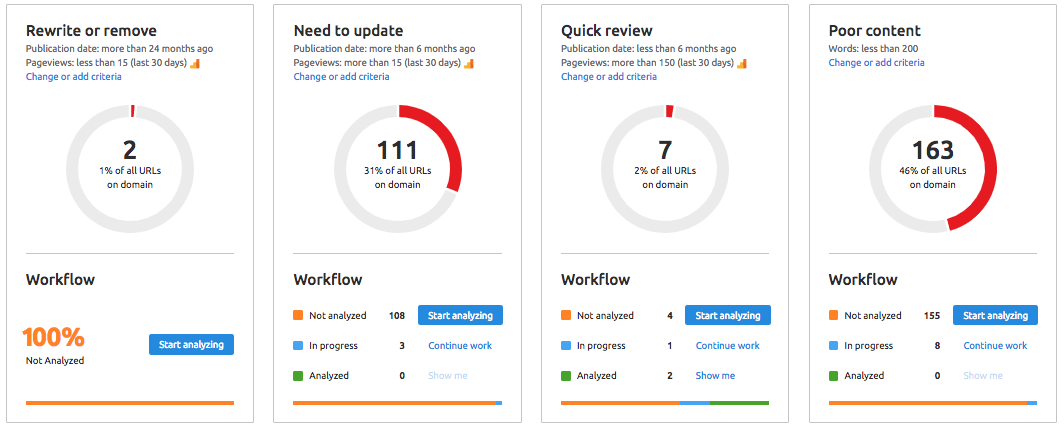
This tool is super helpful when planning each step of the content marketing workflow, from ideation to planning, creation, optimization, and measurement.
This is my go-to tool for keyword and traffic research.
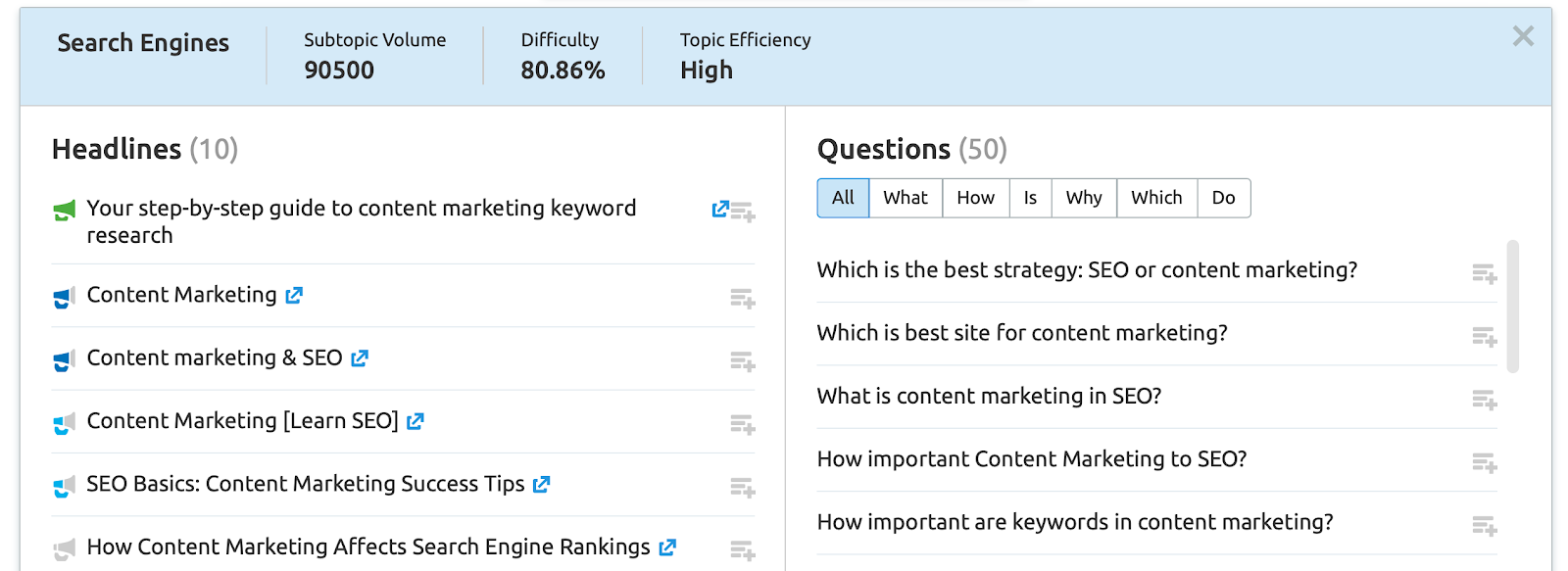
You can actually add topics to your editorial calendar right within the platform. That way, you can manage all your activities (along with your colleagues) and track campaign performance.
To get started, type in a keyword you want to focus on. Then, the platform generates a brief with optimization tips taken from your top competition in search results. It will deliver recommendations on everything — ideal length of your content, the number of links and semantic keywords you should include, and much, much more.
The platform also has a rich-text editor, where you can test the content that targets a particular keyword. It gives tips on SEO, readability, and tone of voice. This is available as a Google Doc add-on and WordPress plugin.
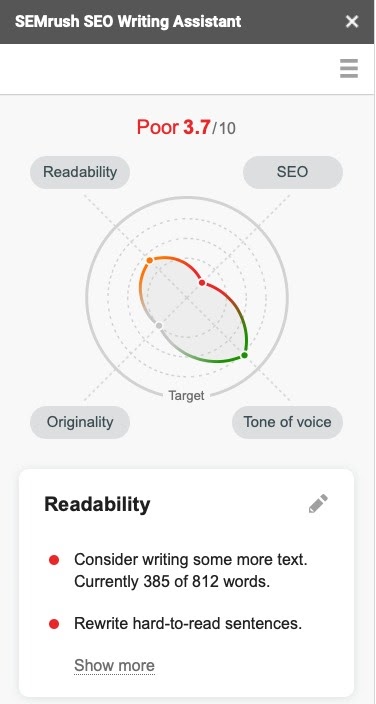
Then, you can use the AI-powered composer to edit, tweak, and wordsmith what you've already produced.
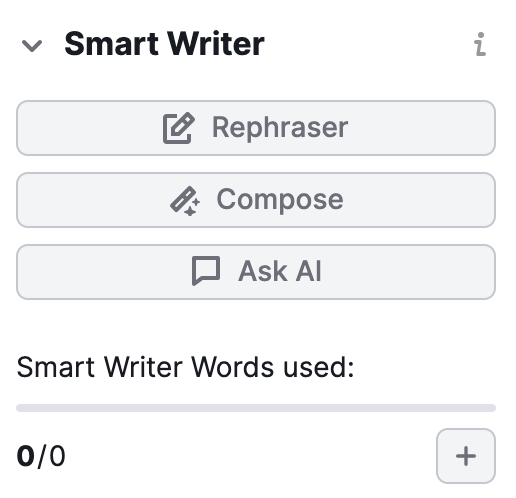
And there's more.
After writing your content, you can audit it right within Semrush. Combining data from Google Analytics, Google Search Console, and Semrush right in the platform, you can analyze any content that is published on third-party sites — either your guest posts or your competitors’ articles.
There are paid and free versions. Click here to get started.
Another great content ideation and strategy planning tool comes from Ahrefs and is called Content Explorer. This tool empowers you to peruse the top-performing content pieces online for a specific topic:
Ahrefs offers a free trial of the product, but if you like it, you'll have to buy it.
Answer the Public is a powerful visual keyword research tool. It looks like this:
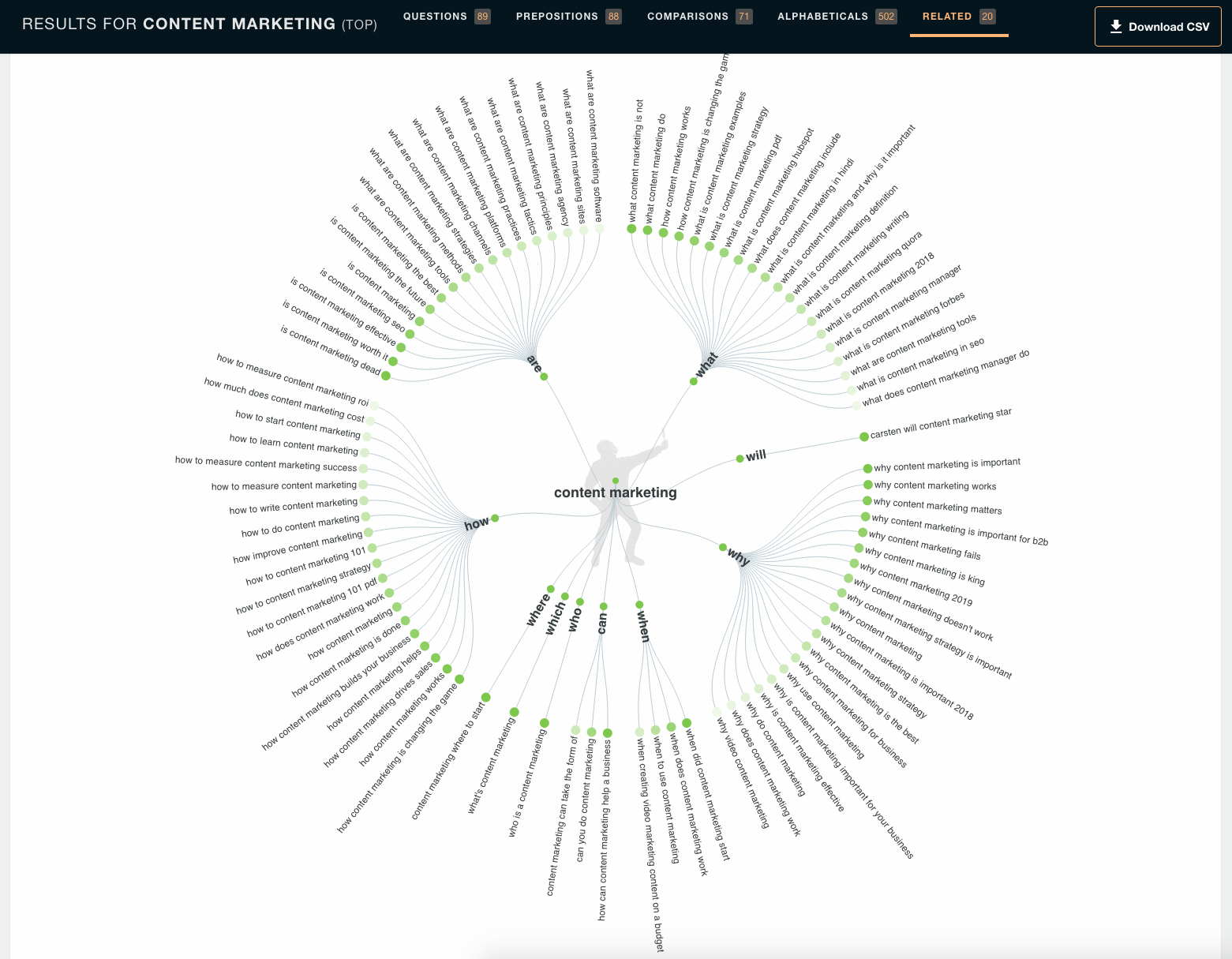
It's similar to Semrush's Keyword Magic tool, but it's a lot more visual (obviously), while also delivering more "human" ideas about what searchers are asking about a given topic.
The only thing to keep in mind is that you are limited to a certain number of free search queries per day – it used to be unlimited, but as of this update, that's no longer the case.
There are a lot of other robust tools and apps out there to help you with your content marketing, but Google Trends is not one to skip.
The simplicity of Google Trends belies its usefulness.
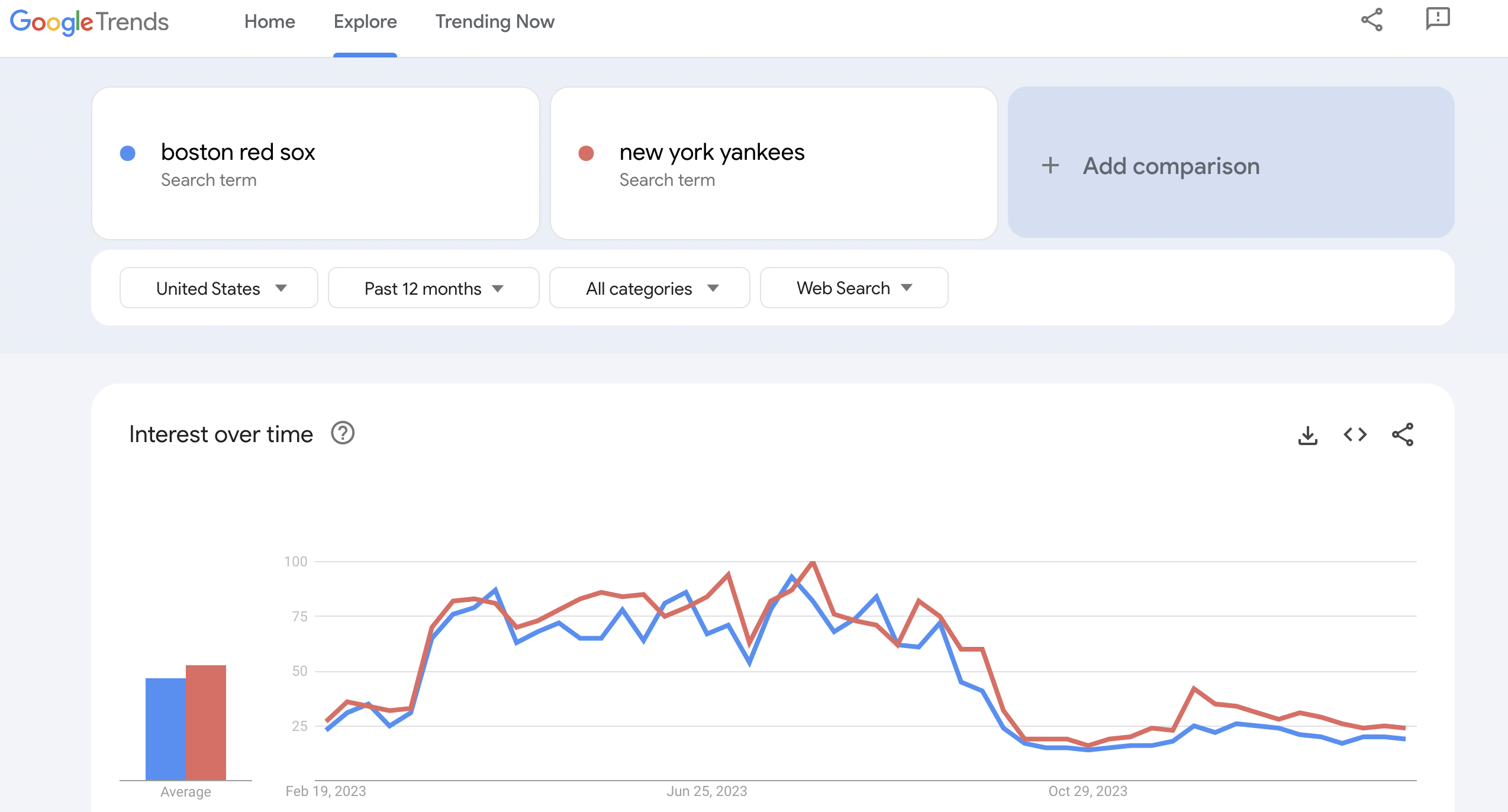
This is an incredibly valuable tool for you to quickly compare related terms to see which has higher search volume, catch topics in your niche on the rise, and so on.
It's a must-have. And it's free.
This next batch contains content marketing tools and apps for when you're creating content or collaborating with colleagues.
Since its release in the fall of 2022, ChatGPT has been a game-changer. Parent company OpenAI has dropped impressive updates and sleek new tools with ever-improving performance.
You can access the less powerful ChatGPT-3.5 for free, but the state-of-the-art ChatGPT-4 will cost you $20 per month.

You can use plugins to help the tool do more — like read a URL or do SEO research — and you can design a custom GPT for a specific task. (In this post, my colleague Mandy York explains how she built a custom GPT that saves her 20 hours per week.)
Personally, I use ChatGPT for summarizing and pulling quotes from transcripts, which had been a laborious process. I also use it as a brainstorming tool. Remember, if you're going to publish anything generated by AI, make sure you fact-check it first. AI can hallucinate and plagiarize, so it's on you to double check.
Dall-E and Sora are image and video creation tools powered by OpenAI. At this point, the outputs still have an inauthentic look to them, but the technology is progressing so rapidly that you must pay attention to them.
For example, here's Dall-E's output from the following prompt: Create a colorful view of the Golden Gate Bridge at sunset, with birds flying in the distance and a large boat going under the bridge.

If you're stuck paying Shutterstock for images, it probably won't be long before generative AI can be a viable replacement.
Sora looks even more impressive, generating photo-real video from simple prompts. While it has not yet been widely released, the initial outputs look stunning:
Trust me when I say Noisli is life-changing.
I used to spend so much time at work trying to find the perfect work playlist on Spotify to keep me on track, but most of the time I find myself distracted by music.
Noisli is a stunning, minimalist (and free!) background noise generator. Or, as they like to say, Noisli is “your productivity companion.”
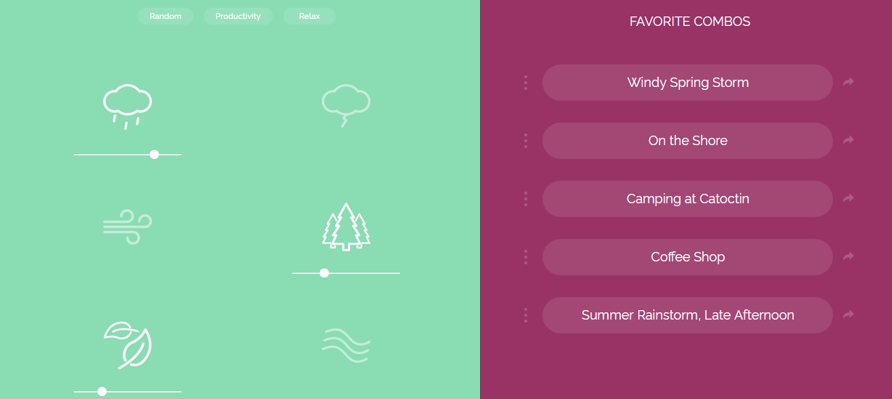
There are multiple studies showing the positive effects of ambient noise on productivity. Now, I’m a total convert, and it’s pretty much all I listen to when I’m trying to get work done.
With my free Noisli account, I’ve created and saved custom blends of sounds— which you control using the soundboard shown on the left — that can set the tone for my entire working day.
Sound options include rain, thunderstorm, wind, forest, leaves, water stream, seaside, water, bonfire, summer night, fan, train, coffee shop, white noise, pink noise, and brown noise. Not sure what those are? You'll have to check out the app!
There are a lot of ambient noise soundboards out there, but Noisli takes the cake for me because of its simplicity. Within seconds of firing up the totally free website, my Chrome extension, or the app, I'm off and running.
Fun fact: You can also share blends of sounds with other people.
Noisli is available for free through the website. There is also a free Chrome extension and iOS app available for $1.99.
If you think back to high school and cringe at the cluttered and distracting writing experience of Microsoft Word, check out Bear.
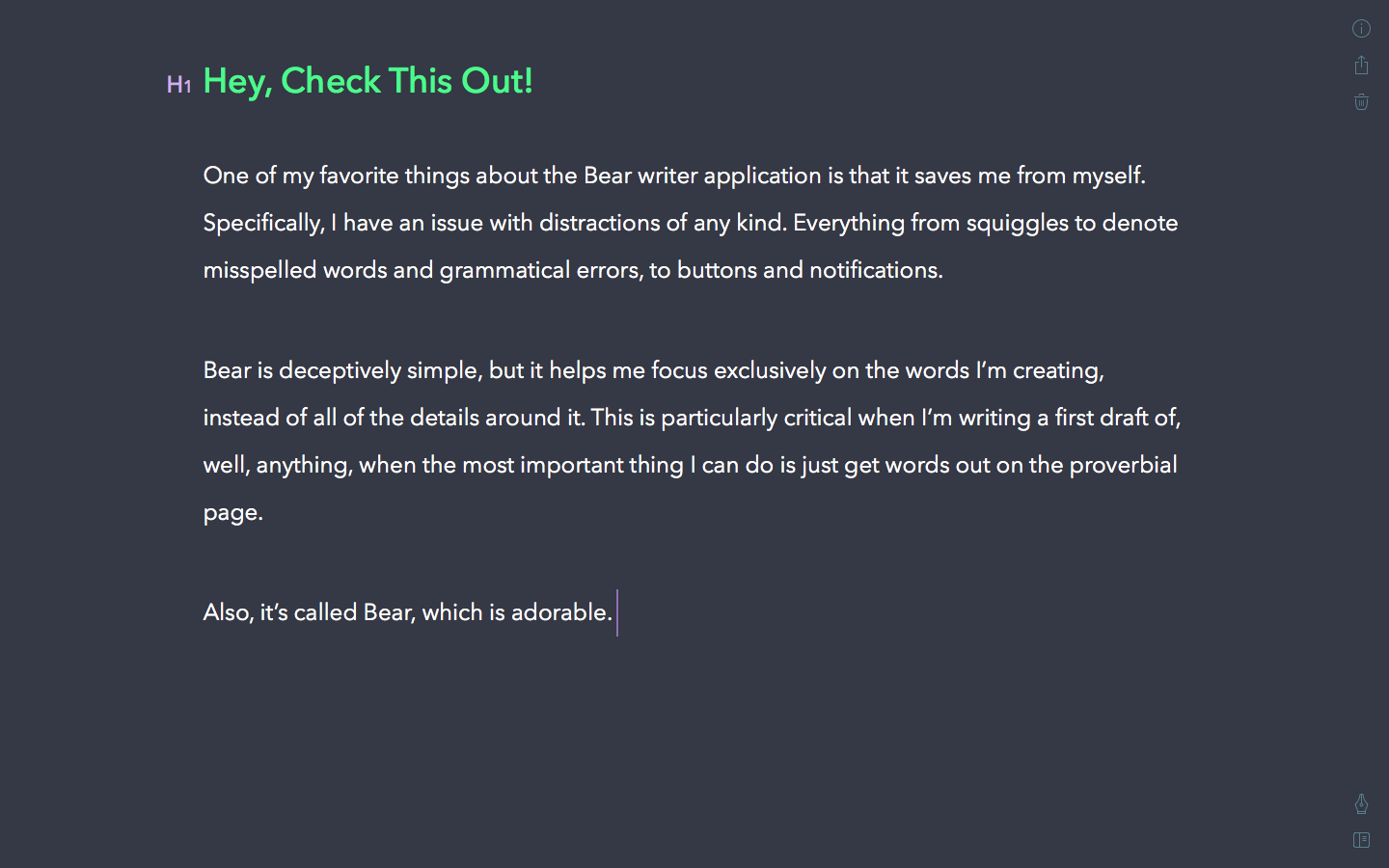
Bear (available only for iPhone, iPad, and Mac) is an app that's all about empowering users to "write beautifully." And it does that so very well.
For a long while, it was my go-to for the drafting of every piece of content I created – blog articles, pillar pages, scripts, you name it. Especially since, in addition to comprehensive and lengthy content creation, Bear can also be used as an Evernote-esque notes application, making it quite versatile.
Bear is free, but if you splurge on the paid version ($2.99 per month), you can enjoy custom themes, syncing across multiple devices, and exporting capabilities.
Ulysses is a neat alternative to Bear, and thousands of writers and content creators swear by it for their writing and drafting needs.
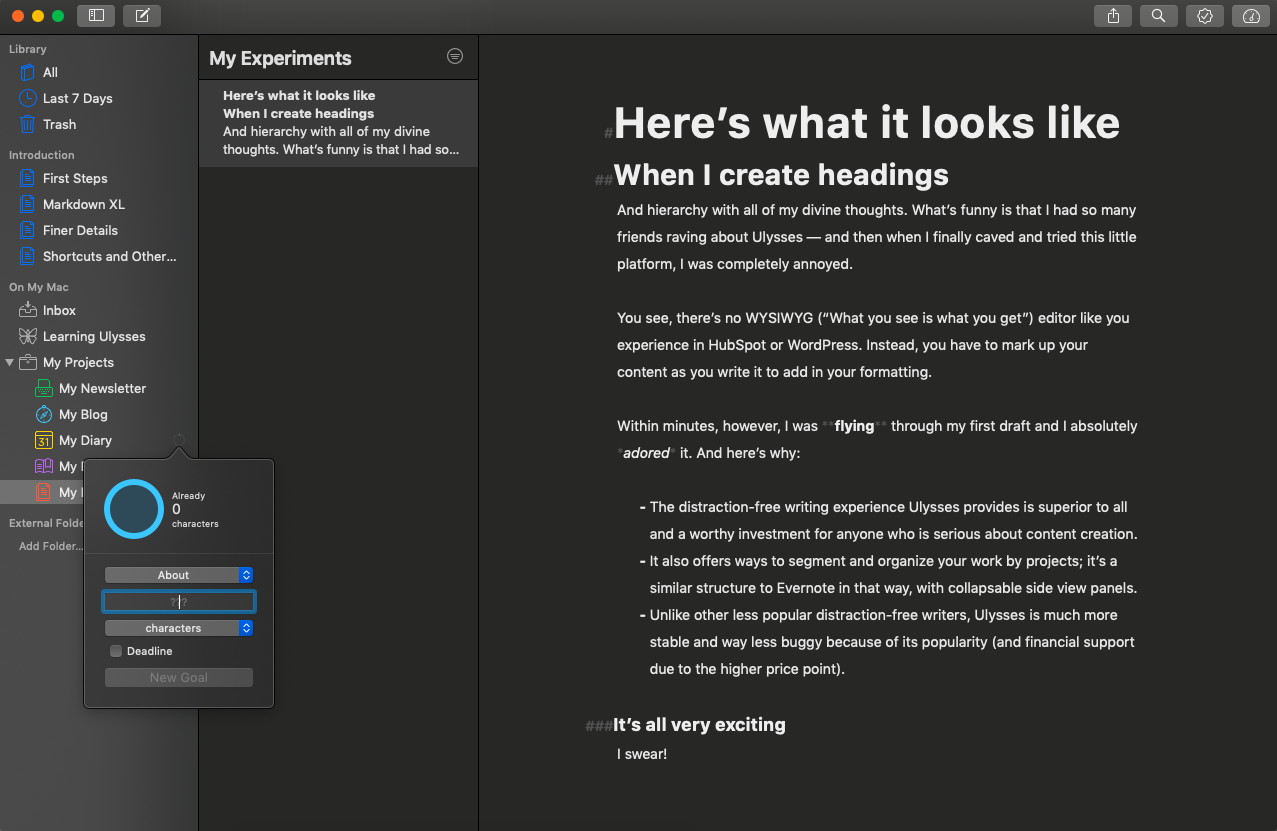
Fair warning, Ulysses (which is subscription-based) is not for the faint of heart. However, it only took me five minutes of using it to become a full convert. (Like Bear, it's also only available for folks who have a Mac, iPad, or iPhone.)
The wide range of features is positively bananas. Because this app has such a devout following, it has the revenue stream that allows it to be more developed and less buggy than other competitors.
To be clear, I don't think this app is for everyone. For some, it may be overkill.
That said, if you're someone who creates a ton of content, and you're struggling to find a way to bring order to the disorganized mess of Google Docs folders, Ulysses is for you. If you want the ability to set goals, see stats, and easily create polished, designed versions of your creations with a couple of clicks, give Ulysses a try.
After a free trial, Ulysses costs $5.99 per month, with cheaper options for students.
Blogabout is a tool we created at IMPACT to help you align with your buyers. Ever wonder what questions are on your customers' minds? The best way to find out is to talk to actual customers and to your sales team.
The second best way is to use Blogabout. Just enter a bit of information and you'll get dozens of blog topics to help you fill up that content calendar.
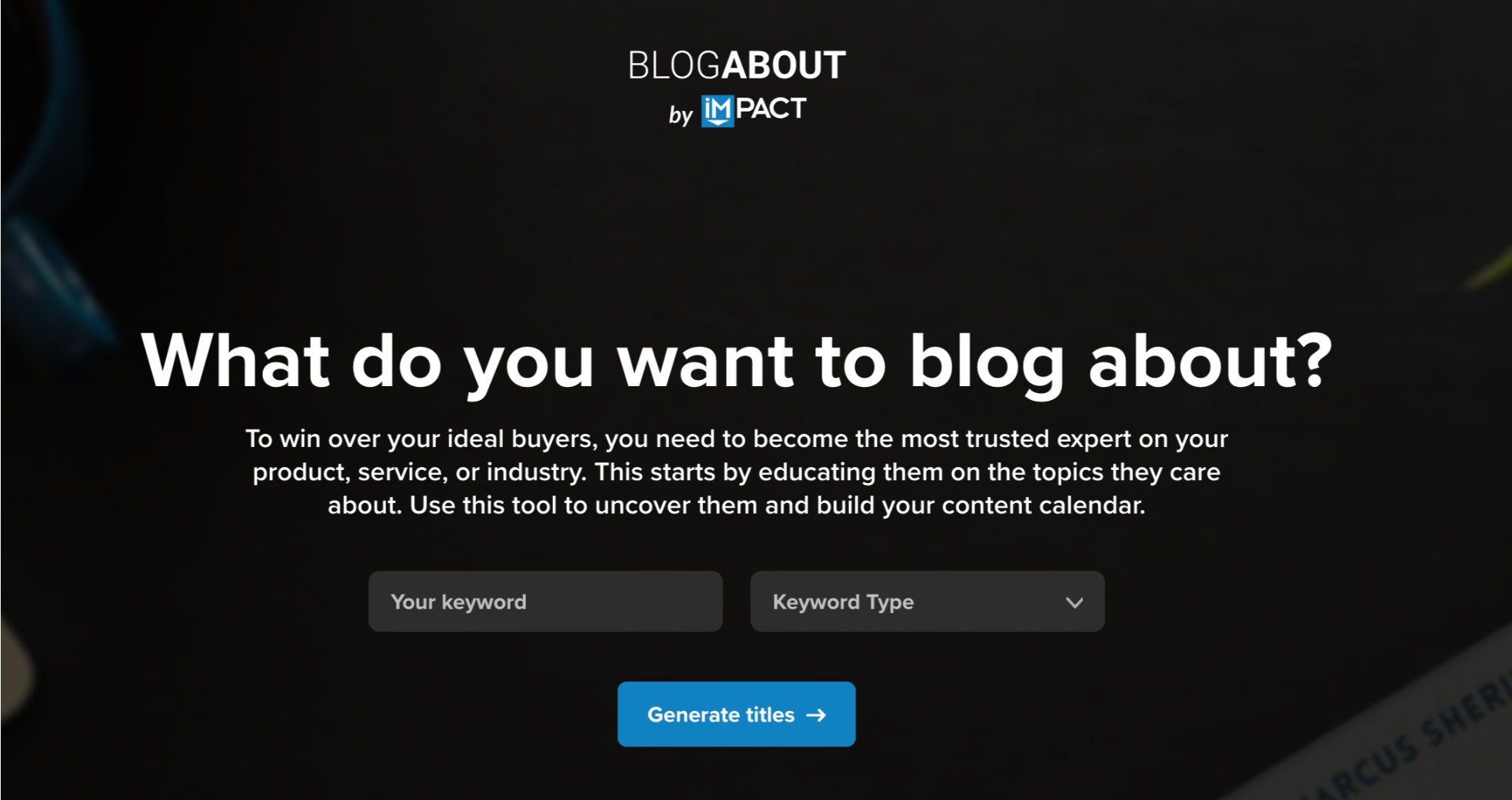
Descript is an all-in-one video and audio editing tool. You can edit videos as easily as you can edit a Google doc, you can pull transcripts from videos, and you can splice in AI-cloned voiceovers when someone flubbs a line.
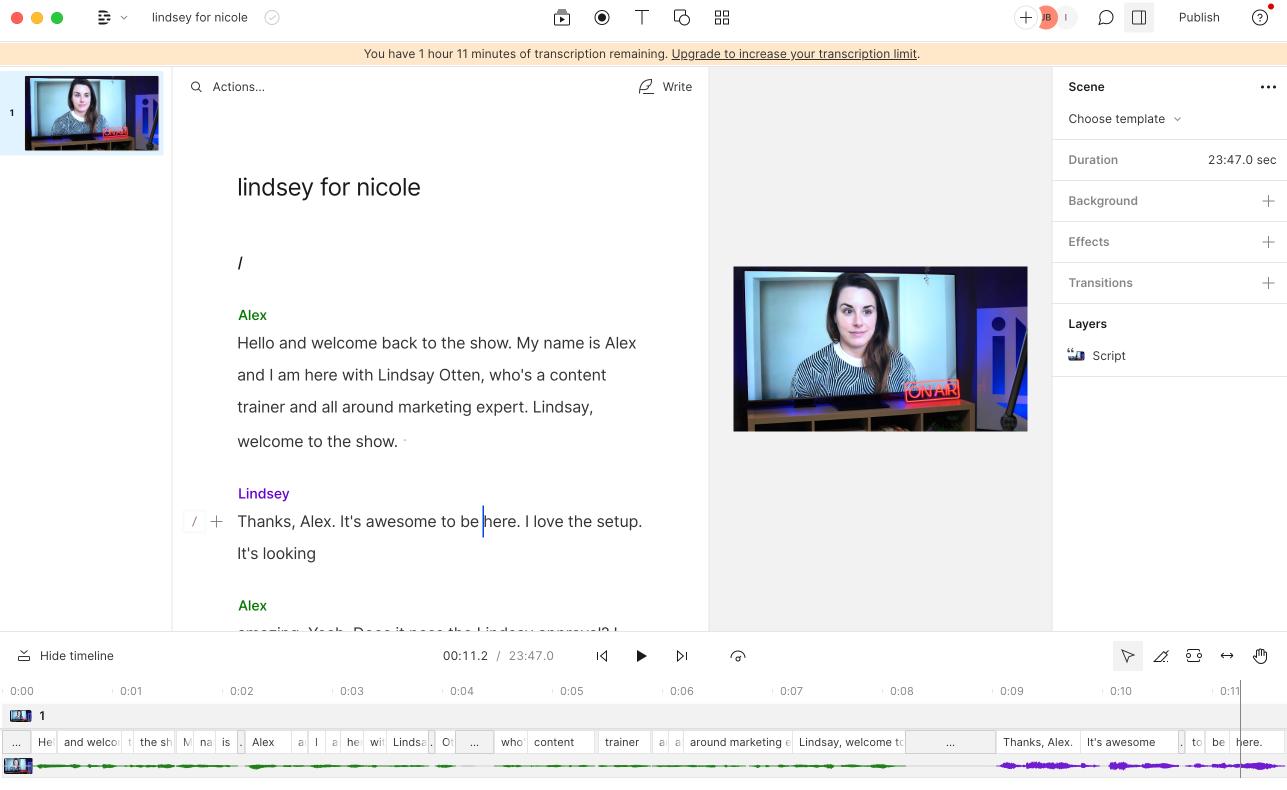 Honestly, the tool is pretty impressive, and it adds new features all the time — including the AI-powered ability to keep your talent's eyes on camera.
Honestly, the tool is pretty impressive, and it adds new features all the time — including the AI-powered ability to keep your talent's eyes on camera.
There is a limited free version, and paid tiers start at $12 per month.
A year ago, I hated being on camera. Today, while I'm still a little squeamish, I'm pretty sure I use the Vidyard Chrome Extension more than any other tool in my arsenal.
I use this free screen capture and webcam recording tool to:
IMPACT's sales team also swears by Vidyard's Chrome Extension for personalized, one-to-one sales videos. (If your team isn't using video for sales, it's time to level-up your sales process.)
Vidyard Chrome Extension is 100% free!
I don't want to bother graphic designers when I just need simple graphics for a piece of content I'm creating, so I use Canva — a fantastic free design platform.
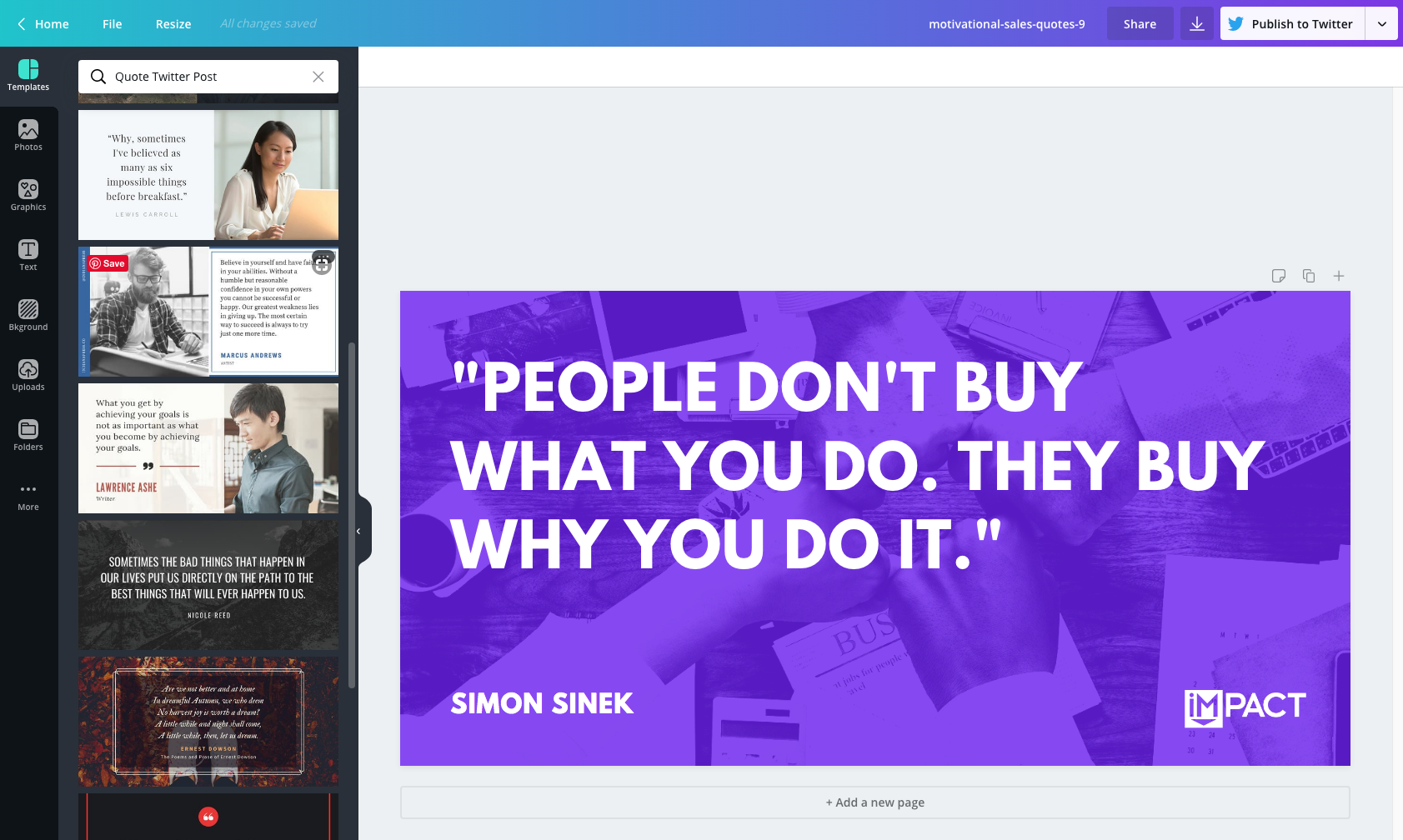
Obviously, Canva shouldn't take the place of your designers entirely. Canva works for putting together quick social media graphics, accent images for content you're creating, and so forth.
With an ever-expanding number of AI tools, Canva keeps upping its game for content creators.
Canva is free, but it also has a pro option for $12.95 per month, as well as custom enterprise pricing for teams of 20 or more.
Placeit is a website for creating mockups — which can be richly helpful for content marketers. You can put an image on a computer, a phone, or pretty much anything else.
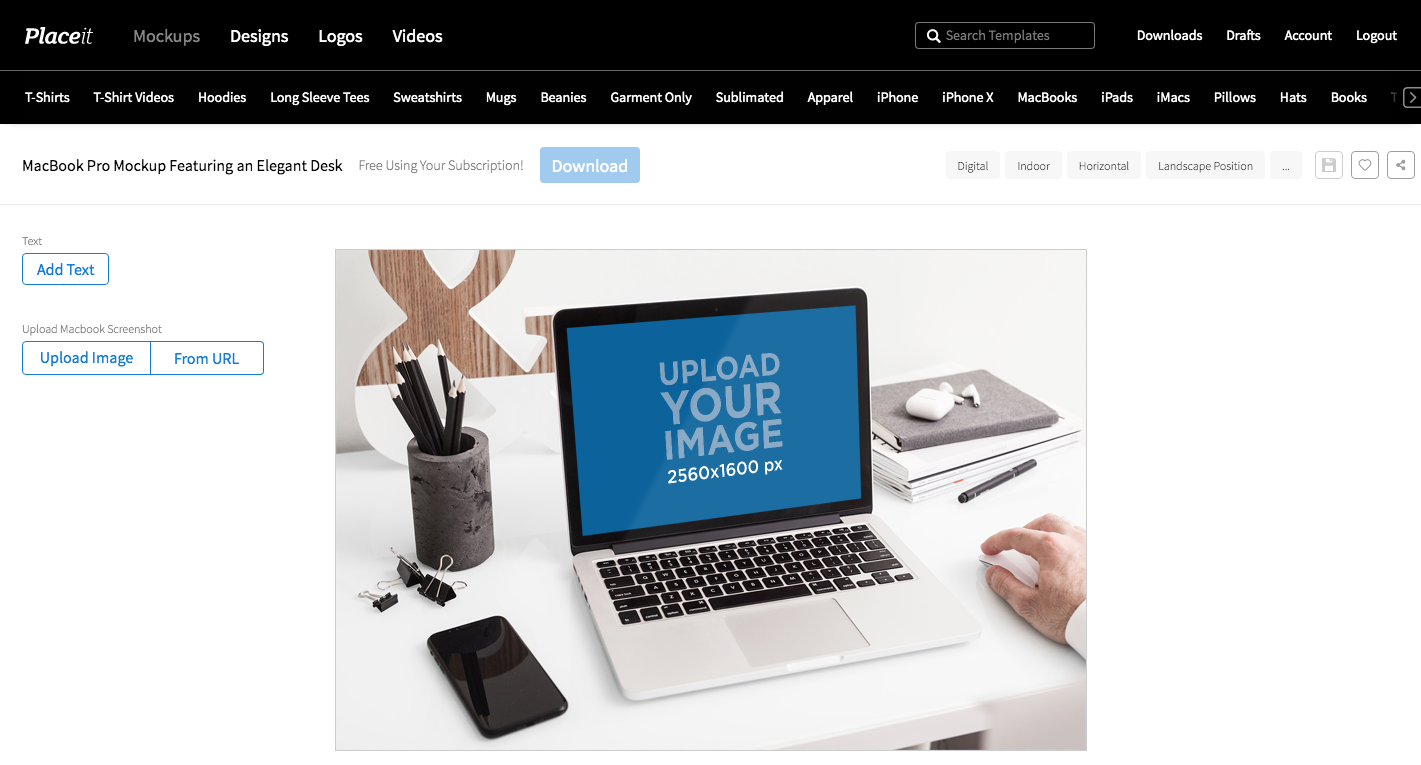
Do they look good? Well, the end product is going to depend on your eye for what a good uploaded screen capture looks like. But the short answer is yes, definitely.
In fact, here are a few examples of ones I've made for other pieces of content...
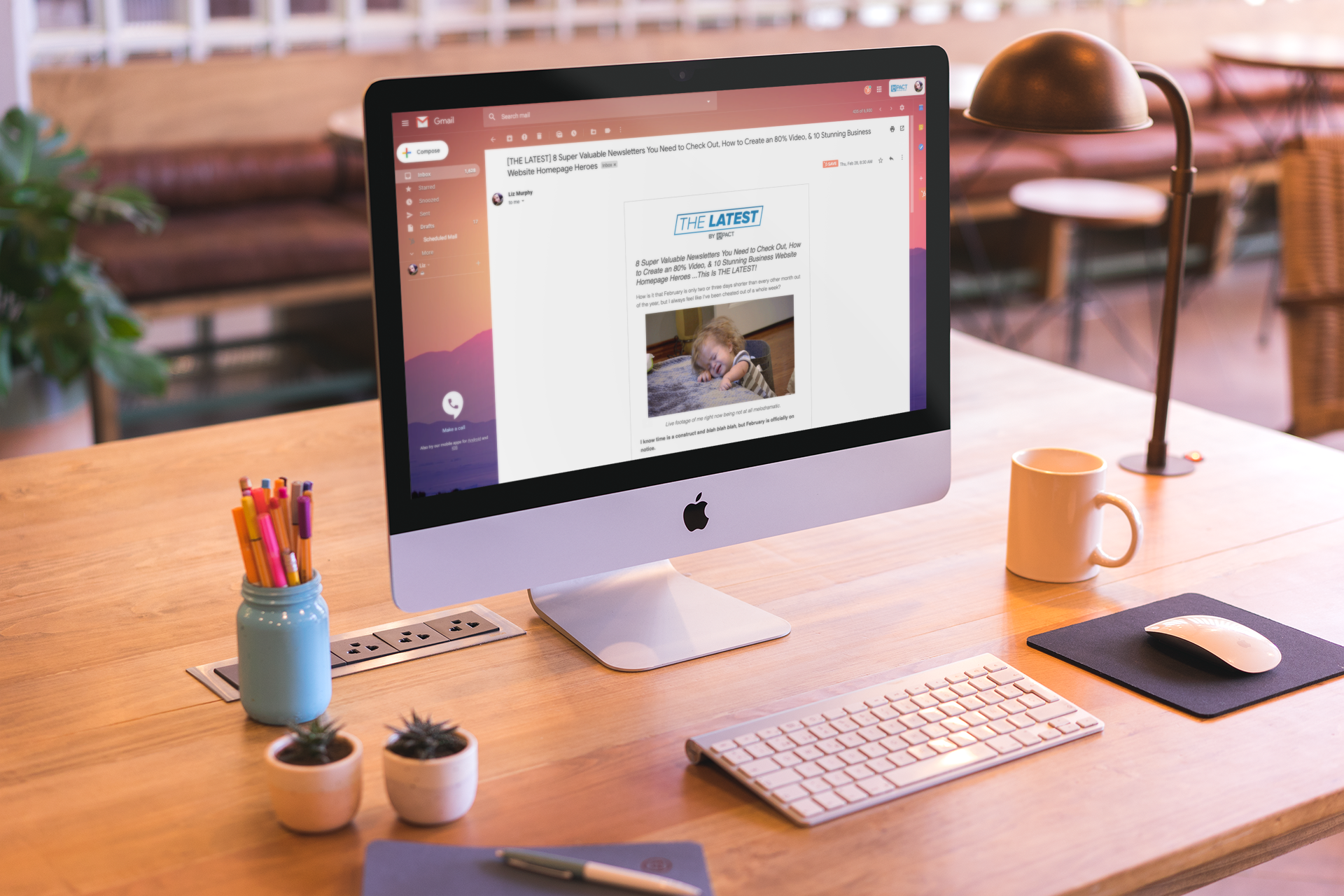
(Used in an article on images vs. no images in email newsletters.)

(A quick little image I threw together of They Ask, You Answer.)
The final product of your Placeit mockup — whether it's a t-shirt, book, computer screen, smartphone, tablet, or mug — will depend on the quality and placement of the image you upload.
Placeit is about $10 per month for unlimited downloads.
Next up are the essential tools to help your writing shine. Use these to make sure you're always putting your best prose foot forward.
Whether you’re a seasoned content creator or you’re a new kid on the marketing block, you undoubtedly know how hard it is to write and edit your own work — because you are too close to your writing to gauge its quality.
Thankfully, someone created Hemingway.
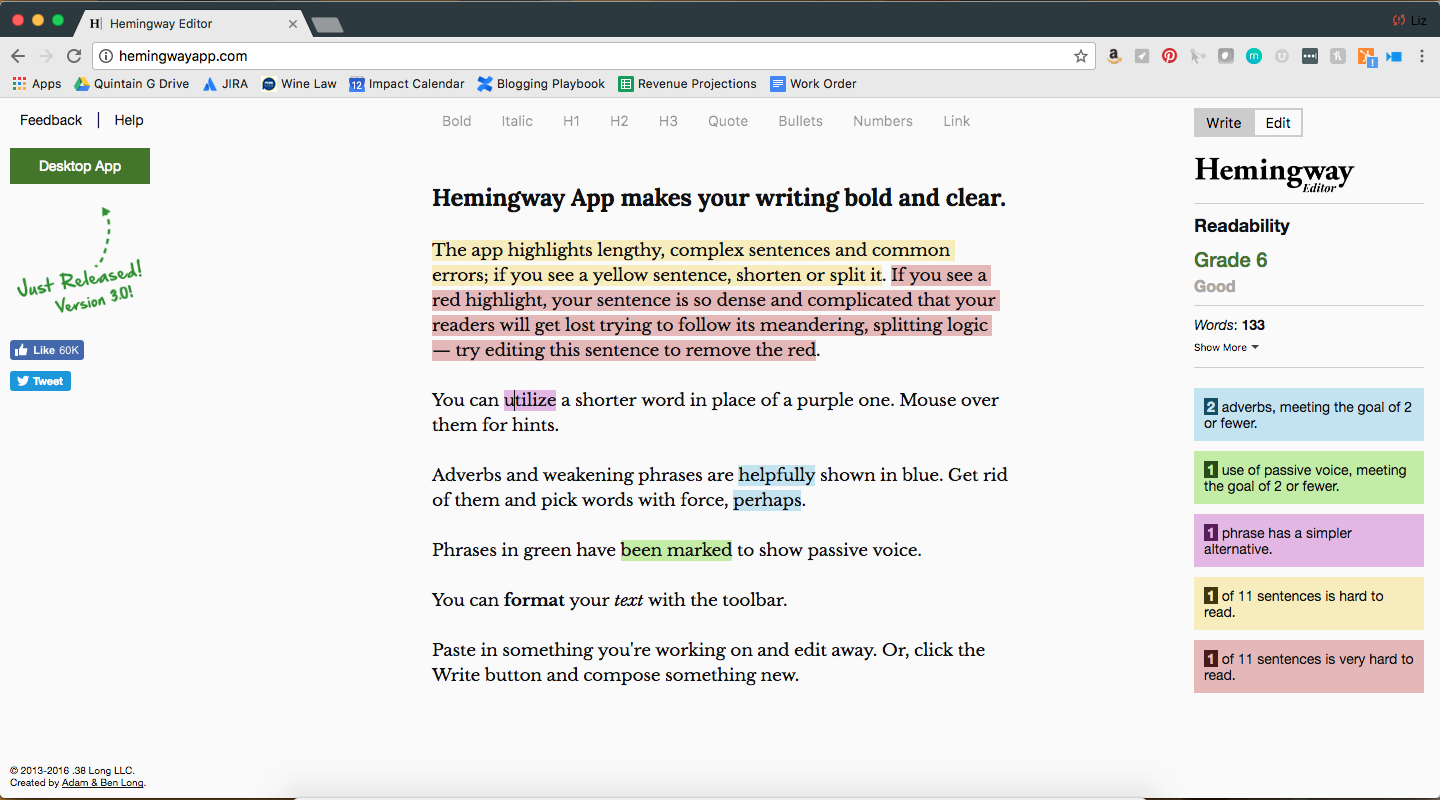
The Hemingway app forces you to evaluate the readability of your work. It tells you what grade level your work reads at, and it scans your work for sentence complexity, passive voice, and overuse of adverbs.
While you have the option to write directly in the Hemingway app itself, I find these kinds of mark-ups to be very distracting while I am trying to form my ideas for the first time.
Instead, I usually type my first draft in Bear and then copy it over to Hemingway when I'm ready to switch my brain over to editing mode. (But how you choose to use this app is entirely up to you!)
There's also an AI-powered writing assistant at your beck and call.
You can use Hemingway for free through your web browser at www.hemingwayapp.com, or you can download the desktop version for $19.99.
Draftback is a free Chrome extension that provides tons of insights into your writing process in Google Docs. You can see how long you spent writing a given document, when and how you made revisions, and more.
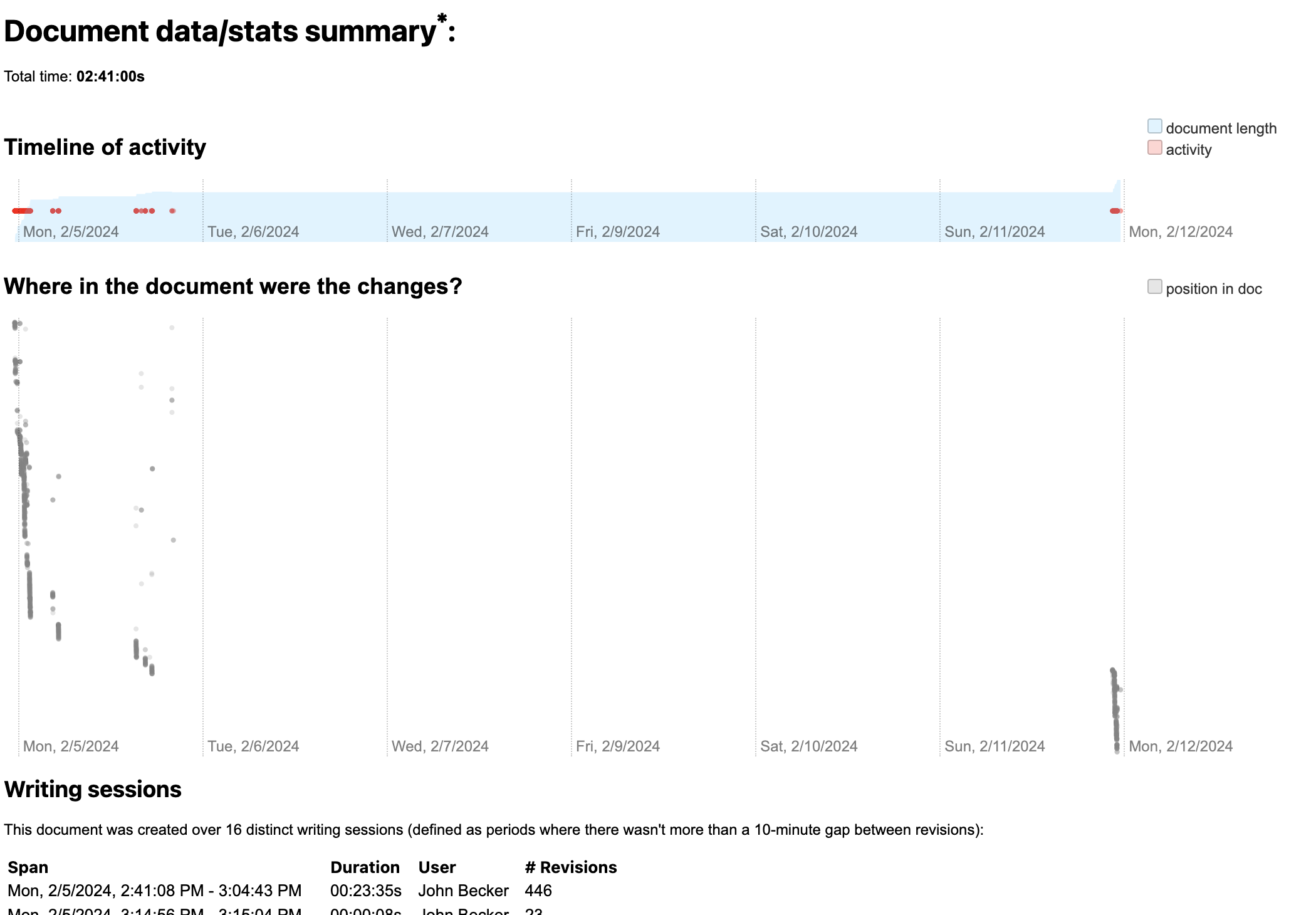
You can even watch a full recording of your actual writing process, should you wish to make yourself suffer.
Draftback is free!
I know, I know. At first, this free-to-use website looks exceedingly straightforward — and it kind of is.
You copy and paste your text into a frills-free box, and you get some data about how many words you wrote.
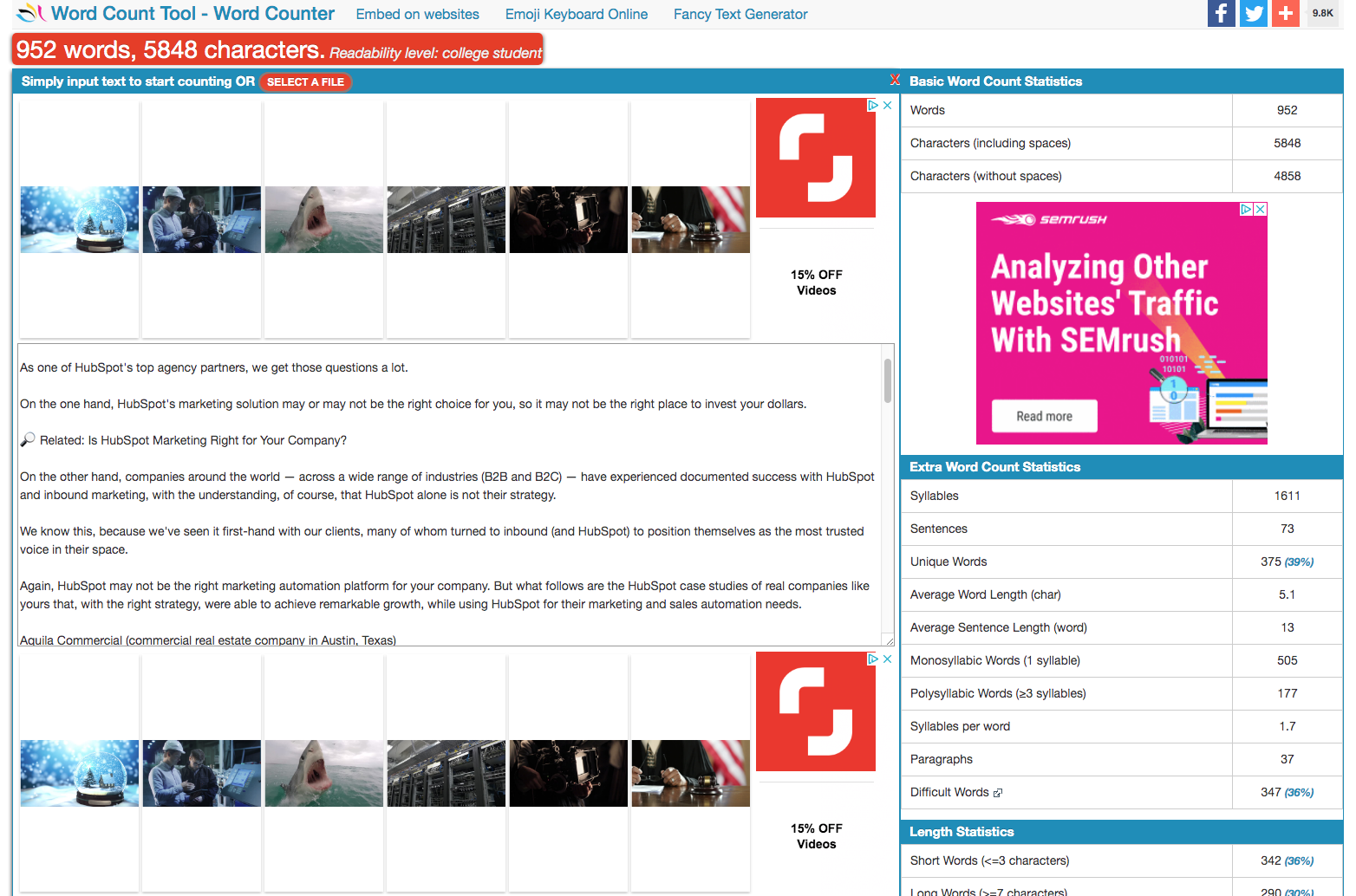
But if you don't scroll down the page, you'll miss three of my favorite things about this powerful little website:
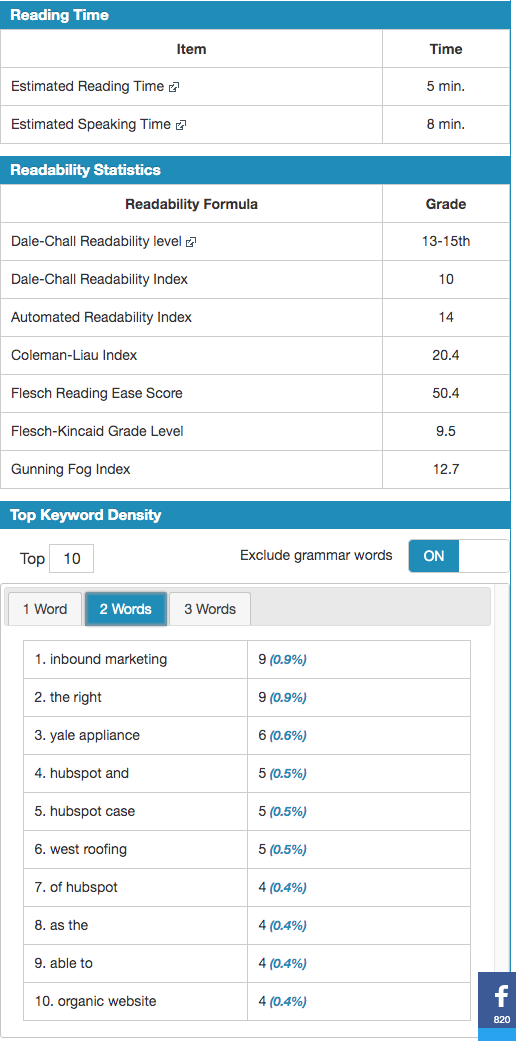
You can see how long it takes to read or speak your content!
On top of that, you get a slew of reading statistics. My favorite thing, however, is that it measures what's called "keyword density," where you can see how many one-, two-, or three-word terms or phrases you repeat throughout your content.
I love that last feature because, not only can I see how many times I feature a keyword (for optimization purposes), I can also catch one of my most common writing ticks with ease — constantly reusing the same words and phrases.
Grammarly for Google Docs is not a separate tool from standard Grammarly. It's just a feature that is incredibly valuable for writers.

For those unfamiliar, Grammarly is a standalone desktop and web app that also has a Google Chrome extension that scans your writing in various places across the web (or as input by you) and provides editorial suggestions.
It's not perfect. As with any technology, there are a few limitations to the tool, but it's great having a digital second set of eyes on what you're writing.
Please remember that no automated editorial assistant is infallible. Grammarly doesn't fully replace the need for you to proof your own work. You must review every suggested edit; never blindly accept them all.
Like everything else on the web these days, Grammarly offers an AI writing assistant that I've found marginally helpful.
Grammarly is free, although you might want to spring for the premium version, as it scans for more nuanced grammar issues that can weaken the quality of your writing.
These are project management and collaboration-type tools to help keep your content marketing initiative humming along.
I can't imagine my life without Trello.
I use it to manage all of my projects and tasks as an individual contributor, broken down by content I'm on the hook for creating, strategic content objectives, team management and administrative tasks, tasks that are currently under review, completed items, and stalled tasks.
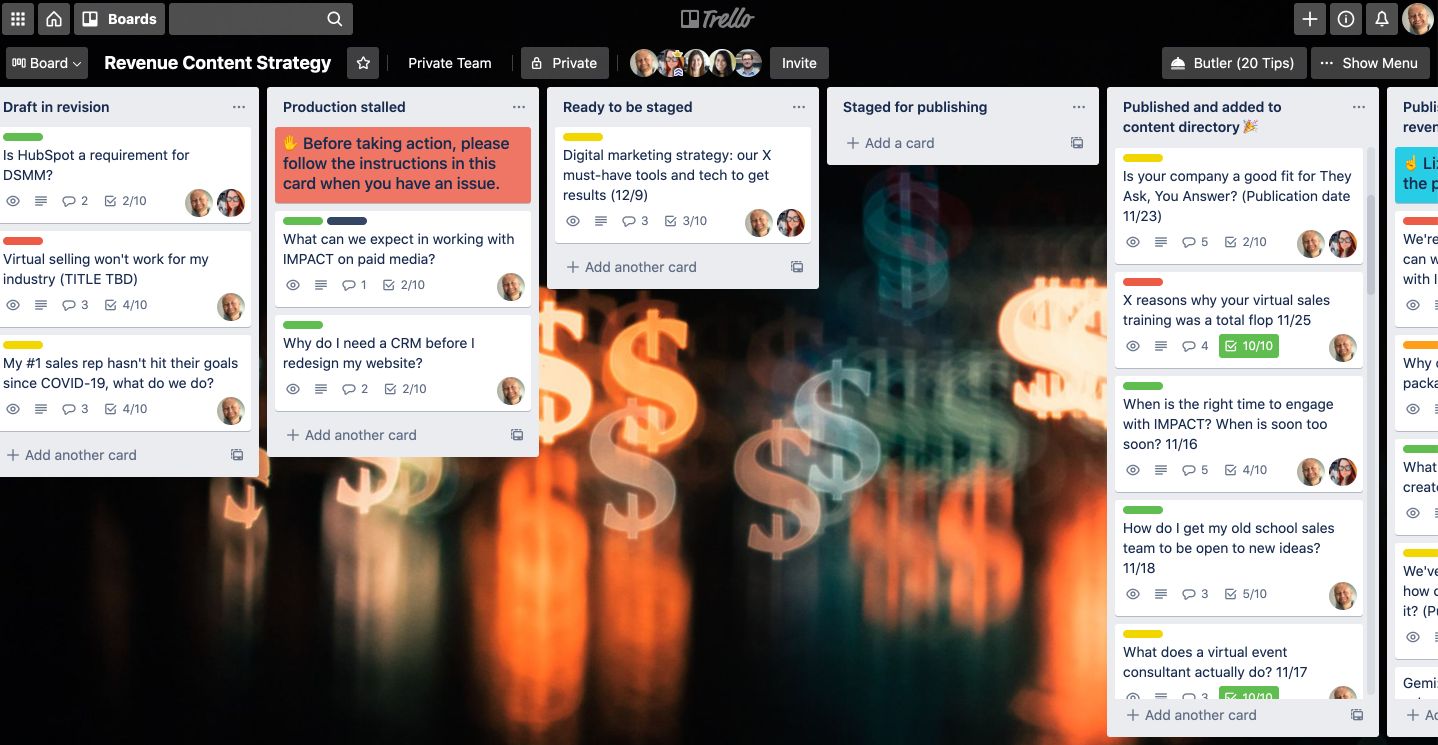
And we've used it to manage the pipeline for our video strategy:
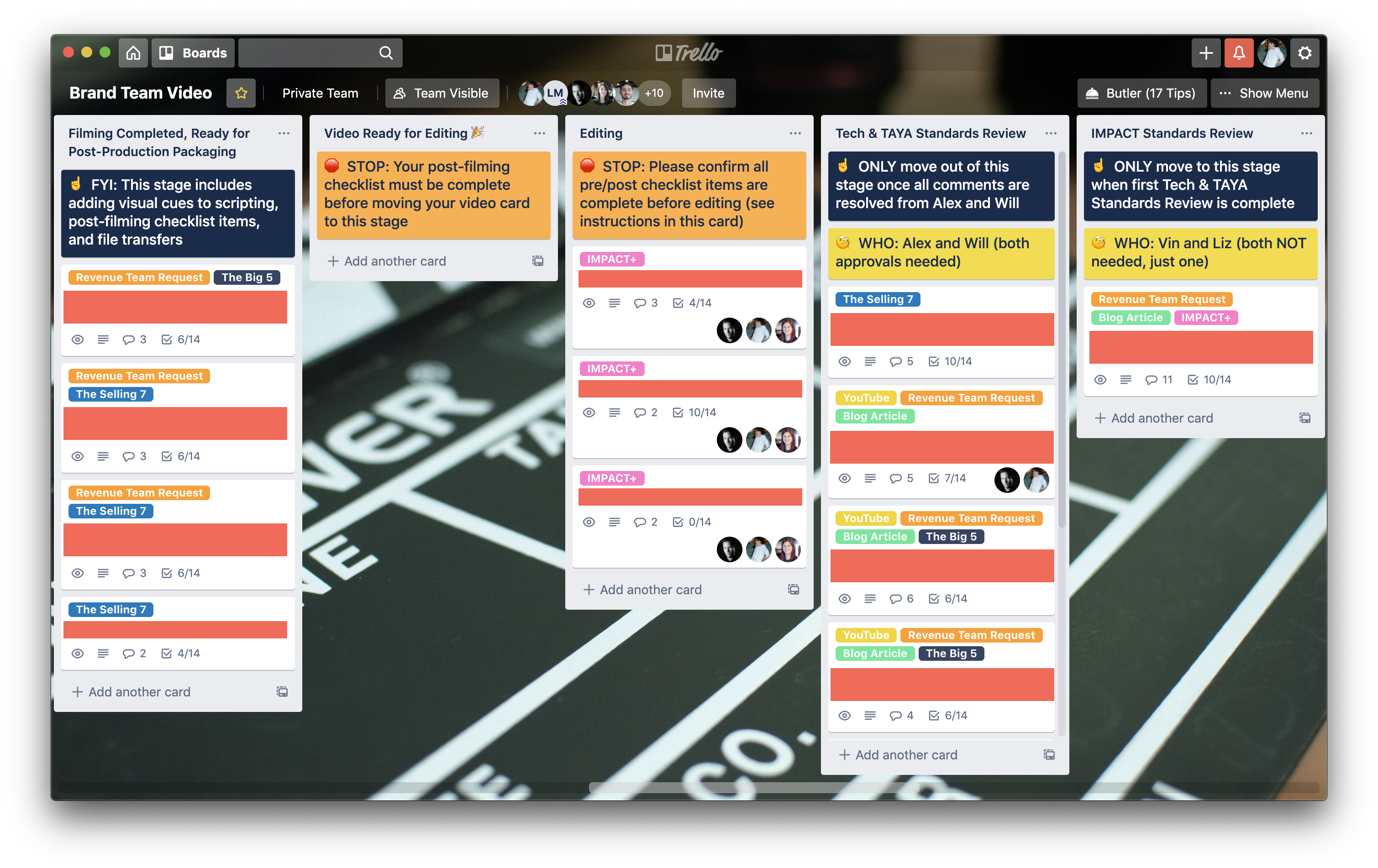
I'm a long-time GatherContent devotee (and I'm going to talk about that next), but for ongoing pipeline management Trello can't be beat.
It's lightweight and easy to start using immediately. You can set up automated notifications for when something is due soon, due now, or overdue. You can keep all communication around a single task in one place. You can customize and adjust your Trello pipeline structure in mere seconds.
Honestly, I can't imagine going back to a world without Trello. I remember trying to wrangle a disorganized series of Google Docs and an endless stream of, "Hey, did you see my comments on such-and-such draft? I'm not sure when it's due, but..."
With Trello, all of that pain went away.
Trello has a free version, plus paid options starting at $5 per month. I've been using the free option for some time, and even at that level, it works really well!
ClickUp describes itself as the one app to replace all the others.
At IMPACT, we've been all-in on ClickUp for a few years now, and I have to say that I'm a total believer.
At its heart, ClickUp is a project management tool, and we use it to collaborate, track comments, and stay organized and monitor time commitments as we move our complex tasks forward.
There's a whiteboard feature, tons of integrations, a pretty nifty AI tool, and intuitive functionality that make keeping aligned easy.
ClickUp is also highly customizable and always seems to be rolling out new features, so it can do pretty much anything you need.
ClickUp has a free version, with higher tiers for teams and bigger companies.
Video is one of the most powerful mediums of content you can create. If your company creates marketing and sales videos that require feedback from lots of people — as they often do — you are going to absolutely love Frame.io.
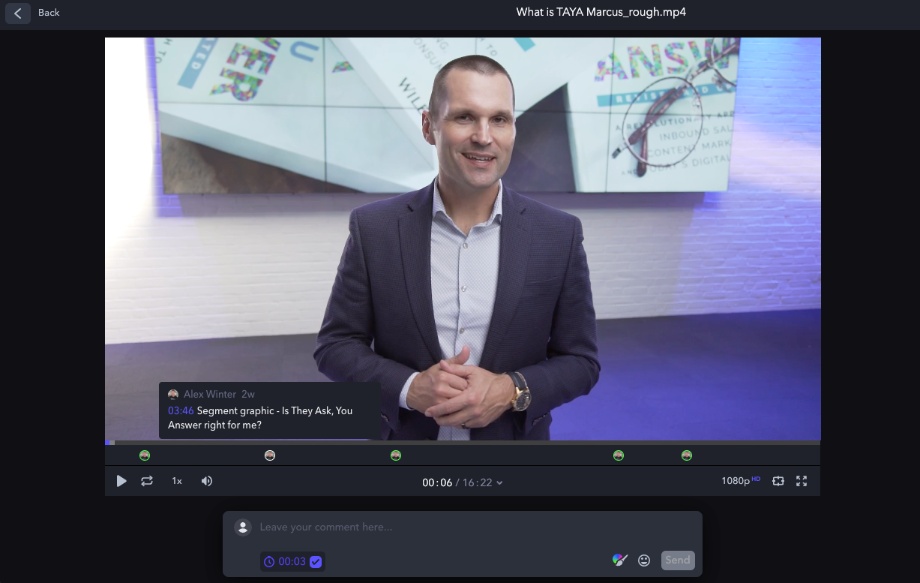
Frame.io is so easy, anyone can use it. Once a rough cut of a video is ready for review by your teams, you can share a link. With a couple of clicks, folks can quickly add comments anywhere in the video.
Frame.io has a free version, as well as options for team and enterprise pricing.
In the wrong hands, stock photography can be the kiss of death. That said, there are ways to leverage stock photography so it actually elevates your content. Custom photography is not always an option and, as we said before, AI doesn't always look right.
Additionally, you need to read the licensing parameters for every photo or image you ever download. Otherwise, if you improperly use an image (for example, some are only licensed for editorial use, even if you buy them), or don't cite an image source correctly, if required, you could end up in a lot of costly legal trouble.
So, with those caveats in mind, here are my two favorite stock photography websites.
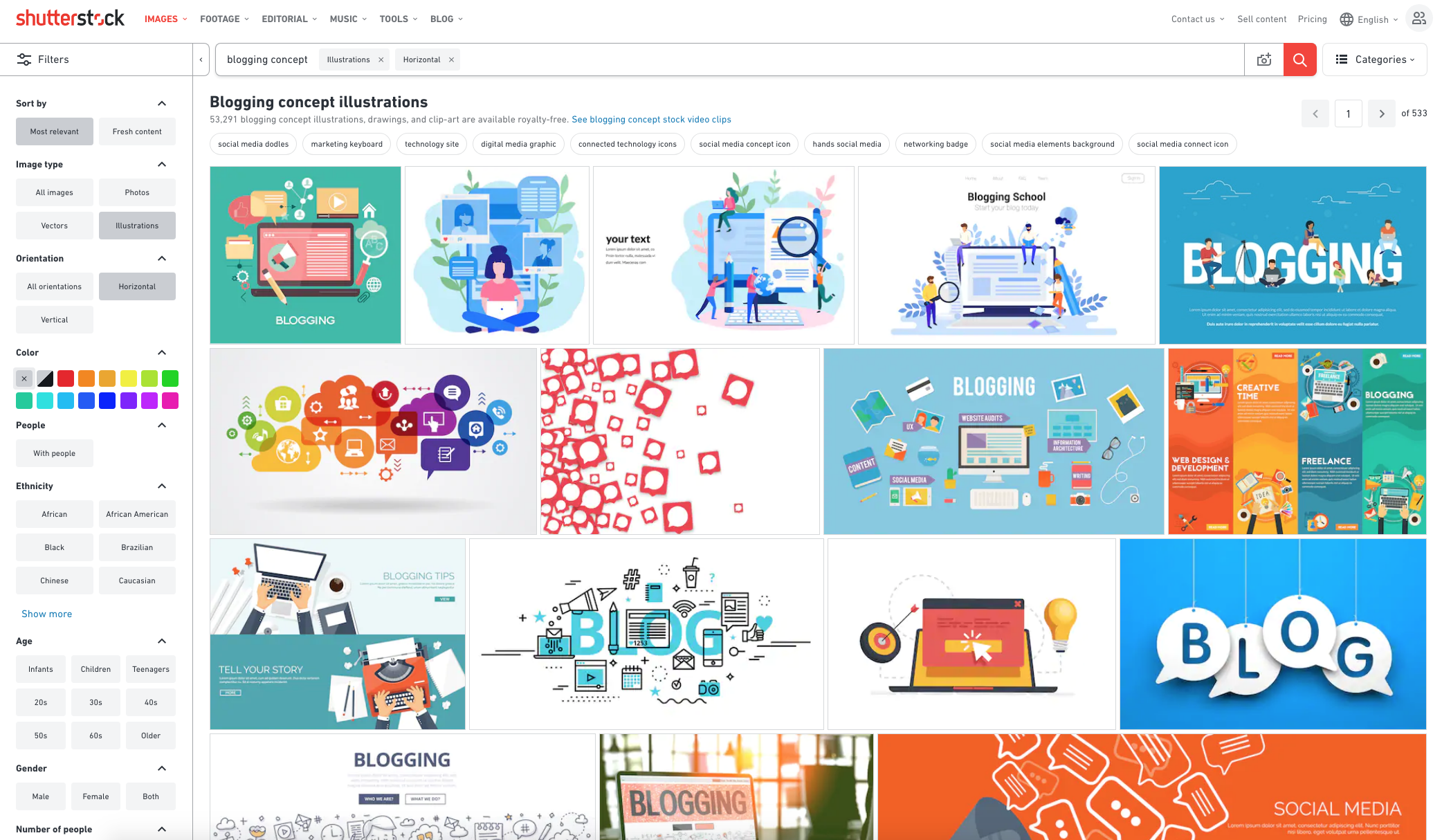
I love that I can sort images by orientation, image type, color, diversity, gender, and so on. Shutterstock makes finding the right image quickly a cinch. Also, in addition to still images, you can find footage and music.
With Shutterstock, you can buy each image individually, or you can purchase a team package, annual package, and more.

Keeping in mind that you need to be really careful about attribution and image use (unless you like inviting legal troubles to your doorstep), Pexels is a great stock image site if you're in a pinch.
Why? Because every image is 100% free and you don't need an account to use it.
Keep in mind, however, that the selection on Pexels is extremely limited, compared to what you'd find on a site like Shutterstock.
But it's great for broad, thematic images that fit a more modern (and a less 1990s, early 2000s) aesthetic.
Pexels is free. Hooray!
There are thousands of inbound marketing metrics you can track, spanning dozens of categories. And if this weren’t overwhelming enough, all the experts and metric-tracking tools — including Google Analytics, HubSpot, and Semrush — have different recommendations of which to focus on.
The most important metric to track — especially when you’re first starting out — is publishing at least three pieces of quality content (articles, video, etc.) each week.
This is because search engines have one mission: Find information that best answers their searchers’ questions and help them meet their goals. When you publish valuable and transparent content on a regular basis, search engines will recognize that your website provides lots of useful information, and you will rank higher and faster in SERPs.
Despite what other sources might say, at IMPACT we believe organic traffic is an extremely important metric to track. For starters, it’s one of the best ways to measure how well your company is educating people (more traffic means more people are finding you). Also, it’s a leading indicator of more inbound leads and sales. The more people that are on your site, the more opportunities you have to convert leads.
Now, is all website traffic great? Of course not. Website traffic is only great if you have the right type of website traffic (which is where The Big 5 comes into play).
After publishing lots of content, it’s exciting to see the organic traffic pouring in; however, you want to be sure it’s not just any traffic — but the right traffic.
Measuring your contact conversion rate can help you gauge this.
To calculate your contact conversion rate, divide new contacts by the number of total website sessions. A strong contact conversion rate means your website visitors are clicking on your calls-to-action (CTAs) and filling out forms, exchanging their personal information for content they find valuable. (A tool like HubSpot will manage this for you.)
When you invest in a content marketing program, this is likely the metric your company will pay the most attention to because you want to know the content you’re creating is not only driving more organic traffic to your site, but that it’s also increasing sales opportunities.
By applying the principles of The Big 5, you’ll attract real potential customers who have problems that your company helps them solve. This creates more (and better) opportunities for your sales team and shortens the sales cycle.
Speaking of shortening the sales cycle, one of the biggest lessons we teach at IMPACT is the importance of aligning marketing and sales. When your sales team and content manager are in step with which pieces of content your sales team needs to close deals more efficiently, the effect this has on your revenue can be incredible.
The revenue team is in charge of developing and executing a content strategy that can be used to increase closing rates and close deals faster — and we do this with the process of assignment selling.
When your website starts ranking for the top keywords in your industry, it shows that your dedication to providing valuable content and being the No. 1 teacher in your space is paying off.
This creates a snowball effect because as your content ranks well, your overall search engine optimization (SEO) success improves — which means more visibility on those search engine results pages (SERPs). In turn, the speed at which your content produces results increases.
When your sales are increasing as a direct result of the content you’re creating, it’s no surprise this indicates a content marketing win. Again, content-tracking tools such as HubSpot can tell you exactly where — specific articles or videos — a prospect entered your site, and how many pieces of content they touched before making a purchase.
This means you will never second guess whether the time and energy you’re putting into your content marketing initiative are actually worth it — you will have the numbers to back you up.
Since the costs of inbound marketing can vary so widely, we’re going to provide average prices based on the assumption that you want the highest-quality work.
You can very well go to Fiverr and get someone to write a $10 blog post for you — or go to ChatGPT-3.5 and get it for free — but it likely won’t be the quality content you need to win over readers or rank in search engines — and the same goes for almost every inbound marketing task.
With that in mind, the estimates here are how much you should expect to pay if you want to see real results.
At IMPACT, we offer comprehensive coaching and training programs that will help you achieve your inbound marketing goals by building internal expertise.
After an average of about 12-18 months, you complete the program and have the skills and experience to own your inbound marketing from then on.
Comprehensive inbound coaching and training will cost, on average, between $8,500 and $15,000 a month. The range depends on how fast you’re looking to reach your desired outcomes, as well as specific recommendations from your coach.
Now that we’ve covered so much of what inbound marketing is and how to implement it, we’re going to leave you with a ton of resources so you can learn everything there is to know about inbound and driving more traffic, leads, and sales.
If you want to be an inbound marketing expert so you can better grow your business, here’s what to do.
Your entire company needs to understand what makes your prospects tick and how to meet their every need if you want to become the No. 1 teacher in your industry. (Hint: You do!)
Learn more about how to align your company around a culture of inbound with some of our resources:
Building a culture of inbound at any company doesn’t happen overnight, but once your entire company is behind you, the journey becomes far easier.
Maybe you need to brush up on inbound marketing basics or you know enough to dive into the more advanced and technical aspects.
Wherever you are in your educational journey, our courses and certification programs can help:
We also have more courses on IMPACT+ where you can try the platform free for 14 days and train on important inbound marketing skills, such as Crafting The Selling 7 videos that convert (the most important videos you can make to improve sales with video) and Inbound lead generation & conversion optimization (how to generate better-qualified leads).
Whether you enjoy reading or listening to podcasts about inbound marketing, these books and podcasts will teach you about inbound marketing in general, alongside some focused core topics, such as selling with video and creating top-notch content.
Books:
Podcasts:
There are countless books and podcasts to choose from, and chances are you will find one that you enjoy. These all contribute differently to the inbound marketing conversation, so while you might pick and choose which you read or listen to, don’t hesitate to aim for all.
Attending these events either in person or online can help you get your feet wet. Some even offer workshops with intense, hands-on learning opportunities that get everyone in a room without distraction so you can focus on how to accomplish the task at hand.
Here’s how you can access information about upcoming IMPACT events.
We also recommend checking out the Business Made Simple, Marketing Profs, and HubSpot websites for information on upcoming events.
Having the right tools in place is essential to help lift your inbound marketing efforts off the ground and ensure you’re on the right track once you start. It’s better to start small and understand the power of these tools rather than jump in feet first and invest in a program or tool you won’t need. So, explore and report back!
At the end of the day, all we really want to do as business owners is drive more traffic, leads, and sales.
All these examples we shared with you here illustrate some of the core concepts of the inbound marketing framework we teach our clients called They Ask, You Answer. Companies that implement They Ask, You Answer in their businesses, and do it well, have incredible inbound marketing success.
To take the first step at implementing They Ask, You Answer in your business, talk to one of our coaches who can walk you through how to see these incredible results at your own company.
If you’d like to read more before you reach out, here are some additional resources:
With strategic coaching and hands-on training for your marketing and sales teams, we can help your company improve your marketing metrics and scale your business with content — more quickly and painlessly than you think!